#invert breeding
Explore tagged Tumblr posts
Text
I NEED THESE BUGS OUT OF MY HOUSE BY TUESDAY 👏
'CAUSE ON TUESDAY I'M HAVIN A POTLUCK 👏
AND I CAN'T HAVE PEOPLE COMING TO MY POTLUCK 👏
ASKING WHY THE HELL THERE'S TWO HUNDRED BUGS AGAINST THE WALL! 👏
CAN YOU IMAGINE THE QUESTIONS? 🤯
"Hey uh.... Why you have so many bugs?" 😐
HOW EMBARASSING! 😱
BUY MY BUUUUUUUUUUUUUUUUUUUUUUUUUUUUUUUUUUUUUUUUUUGS🦋🪲🪳🦗🐜🦂🪰🐞🕷
➡️ Click here to view my new website!
#bugblr#bugposting#my bugs#BUY MY BUGS#for sale#for trade#bdg#brian david gilbert#invert pets#tw bugs#insect#insects#my inverts#invert keeper#invert breeding#invertebrates#this is how you advertise#right??#invertblr
77 notes
·
View notes
Text
Imagine a world with huge centipedes. Not just one that’s a foot or so long or one that’s been extinct for years; dog sized centipedes that are alive and well and can curl up on you for nap time


#we keep breeding dogs with inverted snouts and every-single-joint dysplasia#why can’t we breed big centipedes who can be trained to stand up and beg#centipedes#I love centipedes#my art#my artwork
2 notes
·
View notes
Text
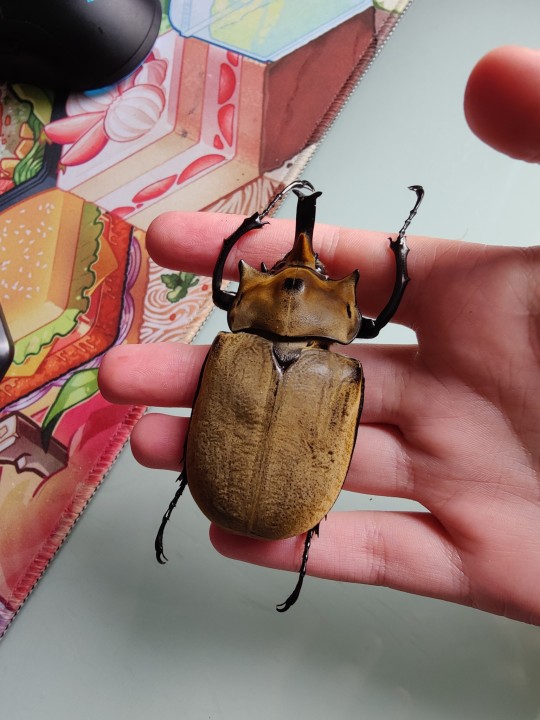



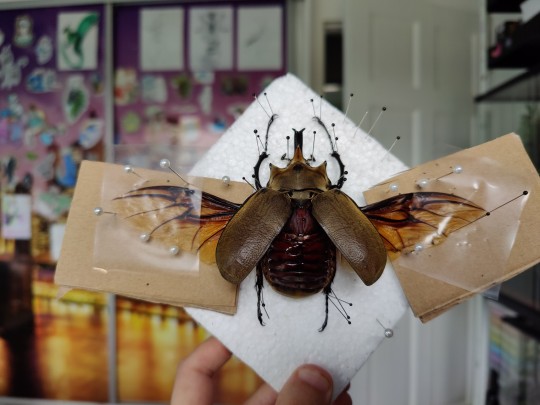
The last elephant beetle in my care ♥️
He took about 3 years to grow as a larvae, and unfortunately only lived a month as an adult.
I had 6 elephants in my care from that batch. 2 have pupated last year (2 years as larvae) and lived about 3~ months as adults. Unfortunately I only have the male from saved as the female was in a lay box (with unfortunately no eggs to show) and grew over with mold.
The last 3 unfortunately didnt make it. 1 died to a badly constructed pupa chamber and sustained incredible deformities that I have never quite seen before. The other two lived up to 3 years as larvae as well, however failed to make pupa chambers altogether and passed away despite my best efforts to help.
This guy at least grew a much more impressive horn than the last years male, which is quite interesting.
35 notes
·
View notes
Text


One of my favorite snails is the Assassin Snail! I've had ridiculous success with breeding them too--started with five in Chaos's tank to start managing a major horde of bladder snails and micro-ramshorns, and with thick natural sand and abundant food not too many months later we had the first wave of an extra dozen leetle Assassins.
Here are the latest eggs I've found on the base of the tank's sword plant! At least four more viable sneggs, plus one I got a good macro of already hatched! They're funky-lookin' little things.
#aquarium#fishblr#shrimpblr#planted aquarium#assassin snail#assassin snail eggs#snail breeding#love my inverts so much#snail
3 notes
·
View notes
Text
i often wonder how ‘growing horns’ ‘putting the horns on someone’ etc came to refer to cuckoldry.
firstly, surely the one committing adultery is the one in the wrong, not the cuckold? like... hes the one being ‘horny’, so to speak
though i guess its an insult against ones masculinity, and having an unfaithful wife (was seen as) more shameful than being unfaithful yourself?
but then surely horns/antlers are a symbol of masculinity, not weakness?
no clue tbqh
#is it something about goats/deer breeding in harems and fighting over females?#but then what about horses?#maybe some kind of inverted pagan thing where horns used to mean 'respectable man' but later meant 'shamed man'?#not sure
19 notes
·
View notes
Note
An outbreak occurs worldwide, reader prepared for it, he was a survivalist fond of preparing for apocalyptic scenarios, a young ex-military man, bitter, paranoid, while others live their normal lives without noticing the patterns of an impending crisis, he was preparing himself, his move to a small town that only a few people, while the majority would try to make a life in the city, lucky for him they were people with a sense of collective and had a sense of survival, anyway, he bought stocks of toilet paper for his stocks, made his preparations in plastic bottles and preserves, had modest plantations (so as not to attract attention, until he surrounded the city) had animals for breeding, mainly rabbits, (other animals were hidden) so as not to attract the attention of the military when they passed by (the others were in hiding), he is also a skilled mechanic and electrician who knows how to fix cars and create things with scraps and spare parts, the scrapyard was his shopping mall, he kept any screws in his jars in the workshop. He also had stocks of medicines, equipment that he bought hidden (which would be the envy of a service station) and knowledge of alternative medicine, that is, how to use nature to your advantage, which plant was good for burners, for example. He had weapons too, an arsenal hidden in his bunker which was below the basement which was a cellar, due to his paranoia he had weapons hidden in the back fake ones in drawers and behind cabinets and pictures.
He only had himself, until a group of girls showed up. Jennie, Lisa, Rosé, Jisoo, Wonyoung, Yujin, Liz, Winter and Karina.
APOCALYPSE'S DESIRE (Part 1)
Smut story
Jennie, Lisa, Rose, Jisoo, Wonyoung, Yujin ,Liz, Winter and Karina x Male Reader

AN: Super love writing this story! I promise I'll give the other girls more action for part 2! Enjoy this part 1 for now! Much love to all of you for the support!♥️
You had always known the world would end with a whisper, not a bang.
The signs were there.
Gas prices didn’t spike overnight—they crept. Cities didn’t crumble from war—they rotted from the inside. Political figures started disappearing from press briefings. The water in your tap started tasting metallic. Even the animals moved differently.
While the world scrolled, laughed, danced in their neon-lit apartments for followers and likes, you were drilling water filters into old wine barrels. Burying medicine under fake garden beds. Logging ammo count in a stained notebook beside your solar rig.
When the blackout started, you were already stocked with enough toilet paper and canned beans to survive three winters. When the first wave of “the sickness” hit, you were 200 miles from the nearest city, your land surrounded by woods, fences, and warning signs.
You lived in the basement.
No—beneath the basement.
No windows, no sound. Just stone, ammo, the hum of the solar inverter, and the slow tick of your own heartbeat. You weren’t lonely. You were alive.
And then they showed up.
Knock knock knock.
You froze.
It wasn’t loud. Just… persistent. Too steady to be wind. Too clean to be an animal.
You grabbed the Glock from behind the pantry door—your third decoy weapon today—and stalked toward the cellar stairs.
Another knock. Louder now. You checked the camera feed.
Nine figures.
Thin. Dirty. One of them leaned against the wall like she might collapse. You zoomed in.
Young. Female. Late teens to mid-twenties. No visible weapons. No armor. No military cuts. Just scraps, hoodies, and tired eyes.
Still—could be bait.
You flicked the mic.
“You’ve got ten seconds to walk away. That’s more than most get.”
A voice answered. Steady, with a rasp.
“We’re not infected. We’re not raiders. We’re just trying to survive.”
A beat.
“Please.”
You let the silence stretch.
You didn’t trust the word please.
Five minutes later, you were outside, weapon in hand, standing behind the reinforced gate you’d welded from scrap and truck grills.
They stood in a loose huddle. Dirty, but not desperate. Not yet. One girl—tall, tan, sharp eyes—stood slightly ahead. Her lips were chapped, but her voice was cool.
“I’m Jennie. That’s Lisa, Rosé, Jisoo. The tall ones—Wonyoung and Yujin. The quiet ones—Liz, Winter, Karina. We’re not armed.”
“That’s your first mistake,” you said flatly.
Lisa, arms crossed, scoffed. “Or our only choice.”
You looked them over again. Jennie had military posture—not trained, but controlled. Jisoo had blood on her sleeve. Not hers. Rosé carried a worn med kit like it was gold. Wonyoung was watching your hands, not your face. Smart girl.
“Why here?” you asked.
“We saw smoke,” Karina said softly. “And rabbits.”
You cursed under your breath. You hadn’t hidden the traps well enough. You nodded slowly, chewing the inside of your cheek.
“You come in, you follow my rules. You steal, lie, or touch my tools—you’re gone. No second warnings. You hear me?”
They nodded, a little too quickly.
“I don’t care who you were before,” you added. “Pop stars, influencers, fucking astronauts—I don’t do fame. I do survival. You eat what you grow. You work. You don’t make noise unless you want the wrong kind of people hearing.”
Jennie met your eyes.
“We understand.”
You paused, then buzzed the gate.
They walked in slowly, taking in the perimeter. You could see the flicker of calculation in their eyes—the coops, the hydro barrels, the silent wind turbine behind the barn. You watched their hunger. Not just for food. For safety. For order.
Winter knelt near a planter box. Her fingers brushed the leaves.
“Lemon balm,” she murmured. “Good for fever.”
You tilted your head.
“You know herbs?”
She nodded once. “My grandma taught me.”
You gestured toward the shed.
“I’ve got a drying rack. You’ll help stock the cellar.”
Her eyes widened just a little. It was the first hint of trust you allowed yourself.
That night, you ate rabbit stew around a salvaged heater.
Wonyoung sat cross-legged, poking the fire with a stick. Jisoo wrapped a shawl around Liz’s shoulders. Lisa cleaned a hunting knife she swore she found on the road. You didn’t believe her. You didn’t stop her.
They asked you questions.
About the traps. The water tank. The solar rig. They weren’t just making conversation—they were studying you.
“Why here?” Rosé asked quietly.
You didn’t look up.
“Why not.”
“No. I mean—why this town?”
You sighed.
“People don’t fight for small towns. They drain them. Forget them. And that’s what I wanted—to be forgotten.”
Jennie’s voice was low. “Not anymore.”
You finally looked at her.
“I’ll decide that.”
They stayed.
You watched them—how they moved, how they rationed. Karina repaired torn clothes like she’d done it for years. Yujin carried logs like they were feathers. Liz never complained, even when her hands blistered.
And slowly, you started locking the cellar door less often.
One night, Wonyoung knocked on your workshop door.
“Teach me to shoot.”
You didn’t answer. Just slid a pistol across the table.
She picked it up. Checked the chamber. Raised it.
“You’ve held one before.”
“My father was military.”
You hesitated.
“He didn’t make it.”
You watched her. She didn’t flinch.
“I’ll train you at sunrise,” you said.
Her eyes softened.
“Thanks... oppa.”
You almost smiled.
It was past midnight when you heard the faint creak of the cellar door.
Your hand slid toward the pistol under your cot out of habit—but the footsteps were light, careful. Not a threat. Not yet.
She didn’t say anything as she came down the old stone steps, barefoot, wrapped in the same faded hoodie she always wore at night. Jisoo’s eyes met yours across the dim space, candlelight flickering behind her like she’d stepped out of some old painting—dirt on her knees, a cut on her thigh from that last scouting run, still not stitched clean.
You didn’t say her name. Just stared.
She stepped closer.
“I couldn’t sleep,” she murmured.
You grunted. “Not my problem.”
She paused, then sat on the edge of the cot anyway. Brazen.
“...You watch all of us like we're ticking bombs. Like you’re waiting for one of us to break.” Her voice was soft, unblinking. “I think you’re scared of being needed.”
Your jaw flexed. “I’m not scared of shit.”
“No?” she leaned closer, her hand barely brushing the side of your leg. “Then look me in the eye and tell me you don’t want this.”
You could smell her—smoke, soap, and something warm beneath it all. Something real.
“You’re playing a dangerous game,” you said, voice low.
Her fingers found your thigh. “I’m not playing.”
You grabbed her wrist—not rough, but firm. Testing. She didn’t pull away.
Her lips parted as you stood, towering over her. “You think I’m some soft-hearted fool who’ll fold because a pretty girl bats her lashes?”
Jisoo stood too, slowly, until her chest brushed yours. “No. I think you’re a man who’s been alone too long.”
Silence. Your hand slid down her side, under the hoodie, finding bare skin. You felt the shiver that ran through her.
“You want this?” you asked.
“Yes.” No hesitation. Just breathless need.
You didn’t kiss her first. You grabbed her. Hands in her hair, mouth on her throat, pushing her back until she hit the cellar wall with a soft gasp. She let you take control. She wanted it.
“Keep your voice down,” you growled against her neck. “Or you wake the whole damn camp.”
“I don’t care,” she whispered. “Let them hear.”
You slid her hoodie off, exposing her bare chest to the cold air and your hungry hands. You kissed down her collarbone, teeth scraping skin, until she was shaking between your body and the wall. Her legs wrapped around your waist like instinct.
Your belt hit the floor.
She moaned—quiet but desperate—as you pushed your cock inside her, raw and tight and perfect. The kind of fit that made you wonder if fate was cruel or kind.
She clung to you, nails digging into your shoulders. “God—been dreaming about this…”
You thrust deep, slow at first, savoring it. Every moan she swallowed for your sake, every roll of her hips, every muffled gasp—it was real. Like breathing for the first time in weeks.
And when she came—biting your shoulder to muffle the scream—you realized you hadn’t touched another human like this in years.
You came inside her, holding her tight, forehead against hers.
Neither of you spoke for a long moment.
Then Jisoo whispered, “You’re not alone anymore.”
And for once—you didn’t argue.
You didn’t sleep much after that night with Jisoo.
Not because you regretted it—no, it was the opposite.
She made you feel something again, something terrifying and raw. After so long alone, her warmth lingered like a fever. Every time you closed your eyes, you could still feel her nails dragging down your back, her breath trembling against your skin, her words—you’re not alone anymore—echoing in your head like a promise you never asked for.
But reality didn’t slow down. The world outside your fences was still rotting, and the people depending on you still needed clean water, working generators, and bullets for the next time the roads brought trouble.
Jisoo didn’t push. She didn’t hover or cling. But you could feel her eyes on you when you walked past, lingering just a second too long. You didn’t know what to make of it yet.
Then the long-range run came up—fuel, batteries, meds. Jisoo volunteered to go. You didn't stop her. You didn’t even say goodbye.
Maybe she needed space.
Maybe you did, too.
Either way, when the truck rumbled down the gravel road and vanished into the trees, only a few stayed behind. And for the first time in weeks…
It started with silence.
Not the eerie, heavy kind—the rare kind. The kind of silence you earned.
Everyone else was gone—off on a long-range scavenging run. Jisoo had insisted on going this time, maybe to clear the air. Maybe to mark her place. You didn’t stop her. You just watched the truck vanish down the old highway, and turned back toward your workbench.
You needed it—silence, time, your hands in wire and grease.
Then you noticed her.
Lisa. Sitting on a crate in the corner of the shed, half-shadowed by stacked metal scraps, watching you work. Not moving. Just chewing gum and swinging one leg over the other.
“How long you gonna pretend you didn’t know I was here?” she asked, smirking.
You didn’t look up. “Since you sat your loud ass down.”
She laughed. “You think I’m loud?”
You turned the wrench harder than you had to. “Only when you want attention.”
“What if I do?” Her voice was slower now. Thicker.
You looked over your shoulder.
She was leaning back on her arms, legs spread just a little wider than needed, tank top barely holding onto one shoulder. You didn’t mean to stare—but she wanted you to.
“You watching me now, oppa?” she teased.
“You think I didn’t notice you eye-fucking me for a week?” you snapped. “You think I didn’t see you watching when Jisoo snuck into the cellar?”
The smirk dropped—just a little.
But she didn’t back down.
“You want to know why I watched?” she said, standing slowly. “Because you looked… hungry. Like someone finally cut your chains loose.”
She walked toward you, boot heels hitting concrete.
“I want that too,” she said, eyes dark. “I want to see what you’re like when you stop holding back.”
You stepped forward. “You’re playing with fire.”
“Then burn me.”
You grabbed her by the waist and spun her around, slamming her back against the shed wall with a hard grunt. Tools rattled on the pegboard. The heat between you was instant, electric—your lips crashing against hers, teeth scraping, tongues fighting.
She kissed like she fought—fast, rough, cocky. But when your hands slid up her back under her shirt, she shivered. Vulnerable. Real.
“You wanted this,” you growled against her throat.
“I want you.” she hissed back, pulling your shirt off with shaking fingers. “Every dirty thought, every rough edge. All of it.”
You spun her around again—facing the wall this time. Bent her over the worktable. She gasped as you yanked her shorts down, your calloused hands grabbing the curve of her ass, your cock already hard and aching against her thigh.
“Tell me you want it,” you growled, positioning yourself behind her.
She looked back over her shoulder, eyes hooded, lips parted.
“I need it.”
You pushed in, hard and deep, pulling a loud moan from her lips as her hands gripped the edge of the table.
The shed filled with heat and wet sounds—your hips slamming against hers, the scrape of metal tools, her breathy little whimpers with every thrust.
“Fuck—you’re big—so full—”
“Quiet,” you grunted, hand over her mouth as you thrust harder, deeper. “Or the birds’ll hear.”
But she liked being caught. Liked the idea of being used right here, where anyone could come back early. You could feel her clench tighter every time you whispered filth into her ear.
“You’re dripping,” you whispered. “Such a mess. You waited all this time, just to get bent over my worktable like a needy slut?”
She whimpered under your hand, nodding.
“Good girl.”
That broke her.
She came hard—legs trembling, body writhing under you—and the way she screamed into your hand made you lose control.
“F-fuck—! I-I’m cumming—so full, I can’t—” she sobbed into your palm, eyes rolling back as her walls clenched tight around you. “Don’t stop—don’t you dare stop—”
Your hand clamped tighter over her mouth.
“You’re taking it so well,” you growled, hips slamming deep. “Messy little thing. That what you wanted, huh? To be fucked dumb in my shed?”
She nodded frantically, drooling into your fingers, breath breaking in high, desperate whines.
“Mmhf—! G-God, you feel too good—fill me up, please—just give it to me—”
You buried yourself to the hilt and came with a guttural growl, spilling deep inside her as she sobbed through the overstimulation, body still twitching around your cock like she couldn’t let go.
After a long pause, you pulled out slowly. She slumped against the table, flushed and wrecked, shorts still around her ankles, a wild grin on her lips.
“You’re gonna ruin me,” she said breathlessly.
You zipped your pants. “Already did.”
She laughed. “Wonder how long I’ve got before Jisoo finds out.”
You didn’t answer.
But you both knew—it wouldn’t be long.
Lisa fell asleep curled against you, breath slow, skin flushed, thighs still twitching from how hard she came.
You didn’t stay long.
You covered her with an old army blanket, brushed the sweat-damp hair from her cheek, and left the shed before the sun could rise.
It wasn’t about regret.
It was about control.
Letting one girl in was already dangerous. Two? That was the start of something you couldn’t fix—a fracture in the fortress you’d spent years building.
You went straight to the workshop and stayed there until your hands bled from over-tightening screws and your ears rang from the grind of metal on metal.
Jisoo didn’t ask what you did that day. But she didn’t need to. She knew. Her eyes said enough when you passed her in the hallway, and the silence she left in her wake felt louder than a gunshot.
You thought maybe things would settle. That Lisa would move on. That Jisoo would calm down.
You were wrong.
It started with a glance.
You’d just finished repairing the solar panels when Jisoo cornered you outside the barn. She wasn’t loud about it. She never was.
“You haven’t been sleeping,” she said, brushing a speck of dust from your shirt. Her fingers lingered too long. “Is it the nightmares again?”
“I’m fine.”
She stepped closer. “You know, you don’t have to pretend with me.”
You didn’t answer.
“You’ve been… distant. Since the others got back.” Her voice dropped. “Since Lisa.”
There it was.
Your jaw clenched. “You jealous?”
She smiled without warmth. “I’m reminding you what we have. Before someone else tries to rewrite it.”
You stared at her for a long moment. Then walked past.
She didn’t stop you.
But someone else was watching.
You found Wonyoung later—alone, sitting on the porch steps with her knees drawn to her chest, dark hair falling over one shoulder, fingers fidgeting with the hem of her hoodie.
“You always stomp off after a fight?” she asked, voice light.
“Wasn’t a fight.”
“Mm.” She glanced up, eyes unreadable. “She’s scared. That you’ll stop needing her.”
You stiffened.
“That’s what you’re scared of too, isn’t it?” she added. “Needing someone. Letting them in.”
You sat beside her without thinking. She didn’t move away.
“You think you’ve got everyone figured out,” you muttered.
“No,” she said, tilting her head. “But I figured you out.”
“Oh yeah?”
“You’re not nearly as cold as you want to be.” She smiled. “You let Lisa touch you. You let Jisoo see you. But me?” Her fingers brushed your wrist. “You’ve been avoiding me.”
“You’re seventeen.”
“I’m nineteen,” she said calmly. “Not a little girl. Not a fool either.”
You went still.
“Besides,” she whispered, voice brushing your ear like silk, “I don’t need to beg for you like the others.”
You turned to her slowly, eyes narrowed.
“Then what do you need?”
She leaned in, lips nearly grazing yours.
“I just need… five minutes alone with you.”
She pulled you by the hand.
Not to your cot. Not to the cellar.
To the storage room—locked, hidden behind the water barrels—where she knew no one would look. And when she closed the door behind you, she didn’t say a word.
She pushed you against the wall.
“You want me to beg?” she whispered, undoing her hoodie. “Or do you want me to earn it?”
You caught her wrist. “You think you’re in control?”
“No.” Her smile was pure mischief. “But I think you want to give it to me.”
She dropped to her knees like a dream—slow, reverent. Fingers tracing your waistband. She undid your belt with an infuriating calm, eyes locked on yours the whole time.
“So tense,” she murmured, freeing your cock and stroking it slowly, deliberately. “So angry all the time. What would happen if you just… let go?”
You didn’t answer. You couldn’t.
Not when her mouth wrapped around you—hot, wet, tongue teasing every inch like she studied you, like she knew what would break you.
“Fuck—” you hissed, grabbing her hair. “You’re a slut, you know that?”
She moaned around your cock, hands gripping your thighs, taking you deeper until you hit the back of her throat. No gag. No panic.
Just control.
And then she pulled off, saliva trailing from her lips, pupils blown wide.
“You gonna fuck me now?” she said softly. “Or are you scared I’ll ruin you too?”
That was the last straw.
You grabbed her, lifted her effortlessly, shoved her against the wall. Her legs wrapped around your waist, panties already soaked, and when you sank into her, her mouth dropped open in a silent scream.
“Oh my god—” she gasped. “You feel—fuck—so big, it hurts—”
You didn’t stop.
You thrust into her hard, deep, the wall shaking with every motion, her back arching as her arms clung around your neck.
“Tell me how bad you wanted my cock,” you growled into her ear.
“I wanted it—since the first day—we walked in and I saw you—so angry, so lonely—”
You fucked her harder.
“You’re mine now,” you snarled.
“Yours—yours—fuck—I’m gonna cum—!”
She came with a cry, pussy clenching tight, milking you, dragging your orgasm out of you in violent, choking waves.
You filled her, holding her close as her body trembled in your arms, every gasp a whispered prayer.
When it was over, she kissed your jaw. Sweet. Innocent.
“She’s going to know,” you muttered.
“Let her,” Wonyoung whispered. “She’s not the only one who knows how to survive.”
The tension didn’t just appear overnight—it had been simmering for days, each small action, each glance, pulling taut the fragile threads between you and the others. But it all came to a head when the first rays of dawn broke through the cracked windows, lighting up the kitchen like the calm before a storm.
You’d just finished stacking firewood in the stove when you felt it. The shift in the air. The weight of silence breaking with every shift of a spoon, the scrape of chairs, the too-loud clatter of bowls and cups.
It wasn’t much, but it was enough.
“So,” Lisa said, voice light, too light. “Anyone else notice how our fearless leader’s been... busy lately?”
Your hand froze on the kettle.
Across the table, Jisoo didn’t look up. Just kept stirring her oatmeal.
“Lisa,” Jennie murmured. A warning.
“What?” Lisa grinned. “It’s not a crime to relieve stress in the apocalypse, right?” She turned her gaze to you, smirking. “And damn, he’s got plenty to give.”
Wonyoung didn’t flinch. She was sipping tea, legs crossed neatly, gaze fixed on the wall like none of this concerned her.
“You’re not funny,” Jisoo said quietly.
Lisa arched a brow. “Didn’t say I was trying to be.”
You stepped forward. “That’s enough.”
But it wasn’t. You could feel the blood in the water now—something primal, unspoken, and about to turn violent.
“You’re not the only one who’s been around him,” Jisoo said, voice low and calm, but her knuckles were white around her spoon. “So maybe don’t act like he’s yours.”
Lisa blinked, then let out a sharp laugh. “Me? You’re the one who’s been playing housewife. Like giving him a little sob story in the cellar makes him your man now.”
“At least I didn’t jump him in a damn shed like a stray cat in heat.”
That one hit.
Lisa stood. “Say that again.”
You stepped between them. “Both of you—stop. Right now.”
“Why?” Wonyoung said, finally looking up. Her voice was soft, almost amused. “Let them. Let them claw each other over a man who’s already bored of both.”
The room went still.
Jennie raised an eyebrow. “You want to add something, Wonyoung?”
“No,” Wonyoung said with a small smile. “I already had my turn.”
Lisa’s eyes shot to her. “What?”
“Don’t act surprised,” Wonyoung said, brushing nonexistent lint off her sleeve. “You thought you were the only one who knew how to be quiet?”
Jisoo stood now too.
“When?” she snapped. “When did you—”
“Storage room,” Wonyoung replied, still seated, still calm. “The night you left for the outpost.”
Lisa turned to you, blinking in disbelief. “You let her—her?”
You didn’t say anything.
Because the truth was: you did. And you didn’t regret it. Not in the moment.
But now?
Now it felt like lighting a match in a room soaked in gasoline.
“You’re unbelievable,” Jisoo whispered, eyes wet now. “You said you didn’t let people in.”
You met her eyes. “I didn’t mean for this—”
“You never mean anything, do you?” she bit out. “You just let things happen. Let people crawl into your bed and pretend they matter.”
The room was spinning now.
Winter and Karina had gone silent in the corner, both watching with wide eyes. Yujin leaned against the wall, arms crossed, lips tight, as if holding something in. Liz… Liz looked like she wanted to disappear.
“If this is how it’s going to be,” Jennie said suddenly, rising to her feet, “we need rules.”
Everyone turned to her.
“This isn't just about him anymore. It’s about all of us. About surviving. You really wanna let jealousy ruin the only safe place we’ve got left?”
She looked at you, eyes sharp.
“We’re not playing harem in the woods. So decide. Now.”
You swallowed hard.
Lisa was glaring at you like you betrayed her.
Jisoo was fighting tears.
Wonyoung? She just tilted her head, like she was curious to see what you’d say next.
And for a moment, you couldn’t speak.
Because you did want them. Maybe not all the same way. Maybe not equally. But they weren’t just tools or passengers.
They were yours now. In some impossible, irreversible way.
But how do you say that?
The air in the kitchen felt suffocating, thick with unspoken words and heated glares. You knew things had gone too far, but there was no easy way to patch this up—not anymore. Lisa's smirk was gone, replaced by a cold look in her eyes.
Jennie stood now, slowly, the tension tightening in her posture. She was quiet, but her presence was commanding.
“We need to set some ground rules,” Jennie said, voice low, but carrying. “Before this spirals any further.”
Jisoo, still standing by the window, crossed her arms. “And what? You think these ‘rules’ are going to fix things? You think we’re going to go back to being a team just like that?”
Her voice broke, just slightly, but enough for everyone to hear. It was raw. Vulnerable.
But Lisa jumped in before anyone could say anything.
“What are you going to do, Jisoo?” She tilted her head. “Gonna keep pretending you didn’t already make your move on him? You're no better than the rest of us.”
“I didn’t—" Jisoo began, but her voice faltered. "It’s not like that."
“It never is, is it?” Lisa interrupted, her voice dripping with sarcasm.
Jisoo’s face flushed with anger, and she opened her mouth to retort, but Wonyoung’s voice cut through the chaos, soft, almost like a whisper, but cutting.
“Enough.”
Everyone froze.
Wonyoung’s gaze swept over the group, calm but dangerous in its quiet authority. Her lips curved, almost imperceptibly, as if she were savoring the power she held in the silence.
“We’re all here because we need each other,” she continued, her eyes landing on you. “If we’re going to survive, we need to stop pretending it’s just about him.” She leaned back in her chair, her voice casual, but the weight of her words was unmistakable. “This is about trust. And right now, trust is... fragile.”
She turned her gaze toward Lisa, then to Jisoo. The others were silent, watching the battle unfold, as if they’d seen this coming, as if the tension between the three of you had been building for days.
“You’ve both been too focused on him,” Wonyoung said, her voice dripping with barely concealed amusement. “Fighting over scraps. But here's the truth: none of us are in control of anything anymore.” She let that sink in for a moment, before adding softly, “Including him.”
The room was heavy with silence. Then Jennie stepped forward, her gaze narrowing.
“What’s your point?” she asked, voice steady but sharp.
Wonyoung’s lips curved into a knowing smile. She was playing a different game—a game that was more dangerous than anyone realized. She wasn’t just speaking to the group. She was speaking to you.
“My point,” she said, her eyes flicking to you with a dangerous, knowing gleam, “is that he doesn’t want to be anyone’s prize. He’s been alone, surviving on his own for so long, and now you’re all trying to fit him into your little world.” She stood up, taking a step toward you, her voice dropping an octave, a little too intimate. “You’re just another thing to survive, aren’t you?”
You swallowed. The words hit deeper than you expected. Was she right?
“What if I don’t want to be part of anyone’s game?” you asked, your voice hoarse.
Wonyoung didn’t flinch. She simply smiled, stepping closer to you. “You’re already in it, whether you like it or not.”
A tense silence filled the room before Karina spoke up, her voice surprisingly firm.
“We don’t have time for this,” she said, crossing her arms. “The world’s falling apart. We need to focus on what we’re here for—survival.”
But it was too late. The damage had already been done.
Wonyoung’s words were like poison, slowly creeping through the group, infecting everyone’s thoughts.
“You really think survival is the only thing that matters, Karina?” Wonyoung’s voice was silky, cold. “We’re here because we’re human. And that means we fight for more than just food and shelter. We fight for connection.”
Her gaze locked with yours again, a dangerous intensity in her eyes.
“And you,” she said softly, “you’re not just a survivor anymore. You’re part of us. Whether you want to be or not.”
The room was a powder keg, and you could feel it. The tension had reached its peak, and no one was backing down. The power dynamics were shifting—everyone was trying to stake their claim.
Wonyoung’s words were a reminder of how deep things were going. The way she looked at you—possessive, almost calculating—wasn't lost on anyone. Jisoo was still struggling with the jealousy bubbling inside her, but now, there was something else in her eyes too. Hurt. Vulnerability.
And Lisa?
She was watching, waiting for the next move, the next spark. Her frustration was palpable, but there was something else lurking behind her cool façade—desire.
This wasn’t over.
#smut fanfiction#smut story#smutty smut smut#smutty fanfiction#smut smut smut#aespa smut#female idol smut#girl group smut#kpop smut#blackpink smut#ive smut#winter smut#smut#karina smut#jennie smut#wonyoung smut#yujin smut#male reader#smut x reader#smut stuff#smut scenarios#smut saturday#kpop story#x male reader#smut thoughts
346 notes
·
View notes
Note
Nikaaa, hi! Honestly, I'm in the middle of a break from tumblr and social media, in general but I suddenly had this thought and just need to talk it out with youu.
Okay, so we all know our lads boys love titties but all I can see is them loving perky, small and big boobies. But how would they react to flat nipples/inverted nipples? Will they be just as hungry for them titties? Would they be totally invested to make them pop? We, humble girlies with shy, introverted nipples need some love and a boost of confidence too, no? All my flat/inverted nipples babes where u at ✊🏻😔
Hiii anon !! You wanted to talk to me? I'm honored 🤗
Tbh when it comes to our lads men a titty is a titty as long as they can cop a feel they're happy. This is probably one of the very few times I will say that when it comes to nipples/boobs in general men are stupid including our lads men. You put a titty in front of them and their brains short circuits.
Zayne & Sylus - going dumb over a titty no matter what it looks like. If you express a lot of concern over your flat or inverted nipples they might suggest surgery, but only if you're comfortable with it and if you're doing it for yourself and not for his comfort because he loves you for more than just your body
Rafayel & Xavier - these two are the grabbers they definitely didn't even notice until you said something. They'd take your shirt off and just examine and pinch your nipples for fun even if you get shy they're the type to be like "You don't have to be shy with me" they would be just as hungry no matter what. I imagine they both wouldn't want you to change anything about yourself
Caleb - He's already obsessed he wouldn't give a fuck that tit is going in his mouth regardless of what the nipple looks like. 1000% reminds you how much he loves everything about you including your nipples. Him and his breeding kink would be like "You can breastfeed just fine with them it's called breastfeeding not nipple feeding" like sir how did we get here?
217 notes
·
View notes
Text
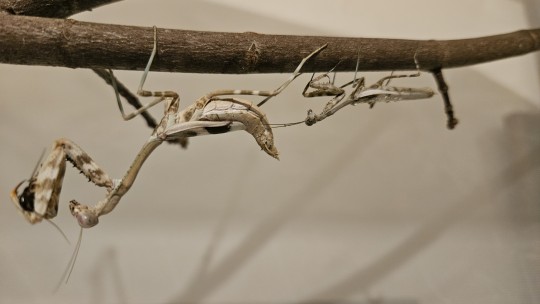
Pairing time for the Budwing mantises! Tortoise (M) & Turtle (F).
#tw bugs#mantis#invert pets#praying mantis#insect#insects#mantises#bugblr#my mantises#my inverts#invertblr#invert breeding#invertebrates#mantis breeding#budwing mantis#budwing#parasphendale
19 notes
·
View notes
Note
forgive me for committing the cardinal sin of commenting on a reblog
personally, i started out with 1 T. over the last ~3 years, that grew to 2, then onwards to 5, a jumping spider and a mantis. one of the reasons i ended up getting more inverts (aside from the fact that I Just Think They're Neat) is because i had a lot of feeder insects that would essentially go to "waste", simply because their lifespan would run out. or if you have crickets those guys are just straight up cannibals and they're stinky. not a vibe
anyway yeah, point is that if you own tarantulas, you'll probably be familiar with their all or nothing eating habits. they will go on hunger strike during premolt, sometimes for months on end, my second T was a sub-adult a. chalcodes that moulted into a mature male who did not eat for the best part of about a year before that moult. i would buy in food for him, in the hopes that he'd eat something, since his age was a mystery to me. i wasn't expecting his first moult with me to also be probably his last, but it is what it is.
on the other hand, the comments about people who have upwards of 100 inverts was something i saw come up in one of the communities i lurk in recently. the point of "what will happen to this collection of animals if you were to fall ill or die or something equally as serious that prevented you from caring for them?" and personally i think that's something that 1. doesn't seem to be something widely considered and 2. is something that probably Should be considered.
even if it's just a contingency plan of "if something happens to me, This Person will care for my inverts" rather than having to leave that decision to someone else that might not make the best decision, or potentially do nothing at all. a relatively small collection would maybe be manageable, because let's face it, your average person would probably not want anything to do with tens or hundreds of big furry spiders.
I'm genuinely curious to know your stance on invertebrate owners? Like, tarantulas specifically. I have one but the people who literally horde them kind of make my skin crawl just like bad snake owners do. Thoughts?
i've never kept inverts but the thing is inverts are usually smaller and don't require something like UV basking setups the way many herps do. I can't tell a good tarantula enclosure from a bad one or minimum space requirements, but i think it is mathematically just more feasible to ethically house more tarantulas per square foot of your house than snakes who are noodles and should be given room to fully extend their bodies
from what i've heard bin systems can work well for many inverts because they do prefer dank environments where they can just chill in the dirt or under a log
@zooophagous can give a better answer than me lol
#its 1:30am i can't even tell if i made the point i started out intending to make#yolo i guess#long post#thankfully in the UK we've got a few breeders that do breed captive inverts#wild caught is not Super common but they still do pop up sometimes
1K notes
·
View notes
Note
Idk if you're into this or if your requests are open but,,,
A ftm reader who hasn't had any hormone treatment or surgeries, getting bitten by a werewolf, which causes him to masculinize, aka grow muscles, become bigger, grow a dick, etc,,, you can do anything you want with it, but there reader knotting somebody and breeding them would be very delicious,,, thank you,,,
Kabr0z Writes Episode 109: Accursed
Find the rest of the Kabr0z Writes anthology here!
Here's the Ao3!
CWs: non-sexual violence; ftm transformation; lycanthropy transformation; mild body horror; knotting; monsterfucking; monster POV
A/N: Monsterfucking from a different direction this time, let's see how it goes!
Another reminder that this series really does rely on requests, and I'm burning through them faster than I'm getting them! If you have an idea, a suggestion, anything, go ahead and drop me an ask to add it to the queue!
#####################################
The helmet didn't really fit you. Nor did the boiled leather cuirass strapped to your tightly-bound chest. You didn't care. The spear felt good in your hand, as did your buckler. The village needs soldiers if it's to survive now the cursemute is gone and the werewolves are abroad again. Tonight is the full moon, they'll be out in force.
You hid a wisp of your hair. You'd wanted to cut it short for years, but your ma refused to let you. You grinned under the steel bucket that passed for your helm, she'd throw a fit if she knew what you're doing. Hell, maybe she already is.
Howling on the breeze.
The guard formed into a schiltron, spears planted in the dirt, mismatched shields held up, ready for attack from any direction.
Shapes darted across the clearing. Shadows in the long grass.
The men either side of you were getting shifty. Nervous. Your heart was racing, your breaths shallow. You put the adrenaline out of your mind, or tried to.
A werewolf barreled at you, leaping from the grass. It landed heavily on you, a scratching, gouging mass of fur and teeth. A huge paw clubbed your helmet, and the lights went out.
That was a month ago. You'd awoken with a nasty gash on your belly, splitting the skin but thankfully not enough to spill your guts. Just meant you had to bandage a little lower, too. Your life in the village was mostly unchanged, spinning and weaving, doing all the ladylike jobs you hated. It did upset you that you couldn't help the men though, it wasn't worth risking splitting yourself open for the sake of feeling manly cutting firewood.
Tiffany came to visit today, she's the only one who knew why you kept washing out bloody bandages by the river. You always liked when she came by. Her golden hair shone even by the candlelight, her sparkling green eyes, her easy smile, she couldn't fail to brighten your day whenever you saw her. She brought you food and ale, and you'd laugh together until well after dusk.
It never occurred to you what may have given you that gash.
You were sat together, drinking and laughing as you ignored the weaving you were meant to be doing. Not noticing the sun setting. Not noticing the clear sky, or the shaft of silver moonlight tracing its way across the floor. Not until it reached you.
The silver light slid onto your skin. A buzzing started at the back of your mind, growing in intensity. Your skin itched, shaggy black fur starting to grow from every inch. The wound on your belly sealed. You stood up, restlessness driving you. The sound of snapping bone filled the workshop as your knees inverted. Blood flowed from your fingertips as claws split the skin. Your skin stretched, threatening to tear as your fingers and arms extended. Your breasts receded as your chest broadened, the bandages binding your body snapping and tearing off you. Your clothes split and tore off you, the simple milkmaid's dress turning to rags as you grained height and width.
Your change took a minute, maybe two. Tiffany was staring at you, mouth agape. Your mind was racing. You could smell her fear. Strong, heady, metallic. She stank. It filled your head. Your heart beat out of your chest. You turned to her. She stared at you. You sniffed the air, delighting in that smell. Fear... Sweat... Something else?
She put her hand on yours. Her other hand went to her skirt, pulling the hem above her ankle. You jumped on her.
You weren't thinking about what you were doing. You ached for her. Your crotch felt tight. A throbbing fullness you couldn't set aside. Your loins burned for her. You were humping at her, rubbing your body against hers, grinding your crotch into her body.
She gathered her skirts, shifting under you, spreading her legs wide for you. Still her eyes stared into yours. Wide-eyed, she still stank of fear. She was your prey. She was your mate. Your mind was torn. Your body wanted hers. You needed to take her. You needed to devour her.
You felt cold air. Every thrust over her made it worse. Something was rising in you, a heavy, throbbing warmth pounding between your thighs. A new smell joined the cacophony in the room, musky, hot, yours. It was painting her. You looked down. A cock swung between your legs, long, thick, the knot still contained in a monstrous, black-furred sheath.
Her feet touched your shaft, guiding you to her cunt. You pressed against her opening, the unfamiliar stimulation against your new cock making you whine. Your precum spurted against her, making her opening even wetter. Her hands brushed your sides and you thrusted.
Your cock drove into her. A moan escaped her lips as you started pistoning your cock into her. You could feel every fold, every ripple of her walls. Your cock was surrounded by hot, wet, clenching flesh. She wriggled underneath you, rocking her hips to meet your animal thrusts. You couldn't hold on long. You felt so close. Your balls rose, tightening against your body. The weight filled you. Pressure forced against your cock. You felt your member fill with your seed, ready to release it.
You thrust hard. She stifled a scream of pleasure, of pain, of terror. Your knot squelched into her. You roared.
Thick cum pumped out of you. You felt every gout leaving your cock, pounding directly into her womb. Every pump made you thrust again, trying to send it deeper into her. Your hips were pressed her against her, but still you ground yourself up to her.
Her pussy was clamped around your knot, holding you in. Her legs wrapped around you. Your mate wanted you to stay. You lay there, buried in her, pumping litter after litter into her fertile cunt.
Dawn broke over the village. Your body cracked and crunched, shifting back to a human form. It wasn't the same human as you were yesterday. Thick hair still sprouted from your body. Your chest was still broad and muscular. You hips were narrower and differently shaped. Stubble sprouted from your face, your softening cock was large and uncut, but a far cry from the knotted monstrosity you fell asleep with.
"You're all mine" you whispered into Tiffany's ear.
She murmured sleepily, dripping your seed, "All yours." Her eye opened slightly "As long as you keep giving me dick like that"
#######################################
Hope you enjoyed tonight's episode! I liked writing from the monsters perspective, it's fun.
Once again, I ask you for requests! Any ideas, scenarios, revisits, what ifs, whatever you want please send it in! If you're on the fence on if it's crossing a line, send it in and I'll make the call on whether or not it gets made.
I'm not here to call people out, just to write porn and be incorrigibly horny!
#textposts#original content#kabr0z writes#ftm reader#trans ftm#gender transformation#monster smut#monster fucker#monster fuqqer#monster x female#monster x human#monster reader#monster#werewolf smut#werewolf reader#werewolf x female#werewolf#werewolves#send reqs#send asks#send me dick pics#send me asks#send anything#werewolf fic#werewolf transformation#ftm werewolf#commissions open#free commissions#writing commissions#shameless smut
66 notes
·
View notes
Text
An Extensive Guide to My Omegaverse/Misceverse
While my version of the Omegaverse that I use in my fics and roleplays has the fundamental basics of the canon Omegaverse, there are several key additions and tweaks.
This post will be a work-in-progress, being updated as I think of other information that needs to be added.

Post under the cut.
Secondary Genders:
Secondary Genders are the foundation of the Omegaverse. They dictate who is topping, who is bottoming, who has heats or ruts. There are three Secondary Genders, which are Alpha, Beta, and Omega, along with subtypes of each secondary gender called Tertiary Genders, which encompass delta, sigma, nu, mu, psi, xi, gamma, digamma, elipson, enigma, zeta, and theta.
List of most common second genders.
Here is some information about the main three Secondary Genders:

ALPHA:
Alphas and alpha-subtypes are the second most common Secondary Gender. Approximately 40% of the population are alphas. They are known for being natural leaders with predispositions towards violence, possessiveness, and aggression. However, a good alpha can also be an excellent provider and protector, caring deeply for their mate and/or pack.

PHYSICAL DESCRIPTIONS OF AN ALPHA:
Alphas are usually larger than betas or omegas. The average height is between 5’7 to 6’4, 140-250 pounds, but this will vary from person to person.
In males, broad shoulders and traditionally “masculine” features are common, along with wide chests and thick torsos, large hands and feet, strong jaws, and a naturally high level of testosterone.
In females, larger frames, narrow hips ( due to inability to become impregnated, therefore rendering null the need to have a pelvic bone wide enough for childbearing ), and thicker distribution of body hair is common. 99% of female alphas are born without a uterus and do not have a menstrual cycle.

FANGS/INCISORS:
Fangs, also known as incisors or “canine teeth,” are a prominent alpha feature, biologically designed for marking their territory ( omegas or other packmates ).
Alpha fangs are usually half an inch to an inch long, and are thicker than other teeth and sharp. The larger the fangs, the more appeal they have. Fang care is very culturally important, with all pups ( no matter their secondary gender ) being taught to thoroughly brush their fangs for at least twenty seconds longer than the rest of their teeth. Bright white fangs and sharper fangs are seen as desirable traits.
Some alphas, especially asexual, aromantic, or aro-ace individuals, may choose to have their fangs filed down by a dentist to show that they do not have an interest in relationships or dating.

KNOTS:
A knot is a thick circle of tissue at the base of an alpha’s member. When they are hard, that tissue inflates into a knot-like formation, biologically designed to be thrust past the rim of an omega’s hole to lock them together while the alpha ejectulates, to ensure that the omega’s body receives as much seed ( also known as cum, semen, ect ) as possible, raising the possibility that they become pregnant.
A common slang term for this is being “pupped up,” or bred, meaning that an omega has been claimed, mated, knotted, and then impregnated by their alpha.
Male alpha knots are usually between two to four inches in thickness. Female alphas, who have an inverted member ( but still fully functioning ) much like that of a male dog hidden within a sheath and will only appear when stimulated, usually have knots that are slightly smaller.

Female alphas may or may not have a vagina. Most commonly they will not, as it would lead to nowhere except in the 1% of female alphas who are born with a uterus, but biological variations have been documented in between 3-7% of the female alpha population.

RUTS:
Ruts are exclusive to alphas and alpha subtypes. They usually occur annually or bi-annually, often in the spring and fall. During this time, an alpha’s instincts drive them to mate and knot a partner, to breed and produce offspring with them.
Ruts last between 3 and 10 days. During this time, alphas will have raised libido and stamina. They may become increasingly agitated, to the point where they may give in to instincts altogether and become “rabid.” This is a slang term, and does not actually mean that they are diseased, but instead means that they pose a serious danger to any omegas in the area, and will be aggressive towards other alphas to the point of physical altercations.
However, ruts can also be triggered by an omega’s heat, or during bonding. More on all three subjects can be found below.
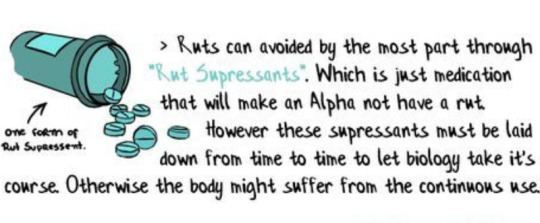
Rut suppressants are an OTC ( over-the-counter ) medicine used to control and prevent alphas ruts, especially ruts brought on from scenting an omega in heat.
An alpha on suppressants will be more mellow, cohabitate with omegas and other alphas better, and experience a lower libido and decreased instincts.
It is recommended by doctors that alphas go off of their suppressants at least once every four years to allow the body’s natural needs to be met. If an alpha suppresses their ruts for too long, they can suffer physical symptoms such as depression, mood swings, intense irritability, increased aggression, restlessness, along with an oversensitive member and body pain. The longer an alpha suppresses their ruts, the stronger their rut will be after they go off of their suppressants.

Who can an alpha mate with?
Alphas CANNOT fully mate with other alphas. Alpha-alpha relationships are not common, but not unheard of. Alpha-alpha relationships will never produce pups, as alphas are unable to become pregnant.
Alphas CAN fully mate with female betas, since female betas have a fully functioning uterus and vagina. Female betas have a low fertility rate but can still become pregnant. However, due to their lack of strong pheromones, female betas are not the most desired mate for an alpha.
Alphas CANNOT fully mate with a male betas, as male betas do not have a functioning vagina or uterus. Alphas who partner up or bond with male betas will not produce pups. Therefore, male betas and alphas do not often bond, but do often partner up for casual hookups to help unmated alphas through their ruts.

PACKS AND PACK ALPHAS:
A pack is a group of two or more individuals that share a bond. This includes tight-knit friend groups, family groups, or polycules.
Not all friends are packmates. Pack is the strongest bond that can be shared between individuals who ARE NOT mated to each other. Mated individuals can still be part of a pack while retaining a special, separate bond with their partner.
Packs often live together, sharing food, rent, and sleeping space. Non-sexual intimacy is crucial for the pack bond to remain strong. Cuddles, hugs, kisses, and sharing beds and nests are all common practices among packs.
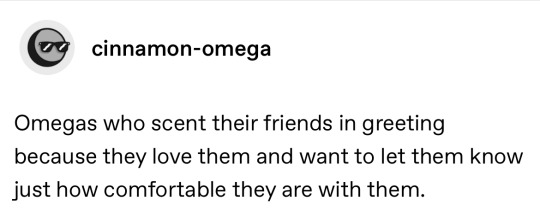
Packs often include siblings or relatives but do not have to. A person can and often is part of more than one pack at the same time. For example, a person may be a part of a family pack ( parents, siblings, and the individual ) and one to two friend packs. Usually a person will have one specific pack they are closest to.
Another common pack structure is that of the POLYCULE. This is where multiple individuals are mated to one another to form a pack like those made by wolves. It is in these packs that the PACK ALPHA is the most prominent figure.
The pack alpha is often the most senior alpha in a pack. They are entitled to control over the other pack members, but may be forced from their position by unanimous vote if they are abusing their power.
In a family pack, the pack alpha would be the oldest alpha relative. This may mean an alpha mother, alpha father, alpha grandparent, or eldest alpha sibling is the pack alpha.
In a friend pack, the pack alpha would be the alpha who had been in the friend group the longest, or the oldest alpha in the group.
In a polycule pack, the pack alpha would be the most dominant alpha. They would have the right to breed and mate all omegas in the polycule, as well as partner up with the betas in the polycule. The pack alpha may, in some polycules, also have intercourse with other alphas in the relationship.

HOW PACK ALPHAS ARE ESTABLISHED:
Pheromones:
Whichever alpha has the strongest pheromonal presence has a natural predisposition to be the dominant alpha in any situation or in a pack.
Pheromones are also known as “scent.” Every person has a scent based on their pheromones that communicates their mood and what their body is feeling. There is a distinct scent for a person who is sad, happy, angry, or anxious. Alphas and omegas have the strongest natural pheromonal scents.
Physical strength or seniority:
Whichever alpha is physically the strongest may be more likely to be a pack alpha. This will usually not apply if there are multiple younger alphas in their prime versus a senior alpha, as an older alpha will naturally hold a more authoritative presence.
Unanimous decision:
Oftentimes, an alpha will become the pack alpha simply because they have proven that they can protect and provide for their pack. An ideal pack alpha is firm but not harsh and possessive but not controlling. This is often the case in family packs.
For example, a family might have an alpha father and beta mother. They would have children, thus creating a pack. Because the father is the most senior alpha, he would be considered the pack alpha.
Another viable example would be a polycule with two alphas, two betas, and one omega. The pack alpha would be the one of the two alphas who is stronger, more dominant, and has a more prominent pheromonal presence. The pack alpha will likely “pup up” the omega, mate and bondmark the betas, and packmark and bondmark the other alpha. The other alpha may be allowed to also mate with the omega and betas, depending on the polycule’s personal decisions and consent.

PACKMARKS, BONDMARKS, AND SCENT GLANDS:
Scent glands are one of the most important things to understand in the Omegaverse. Scent glands are small glands beneath the skin, often appearing as a bump or not at all, that produce pheromones and the unique “scent” of alphas, betas, and omegas.
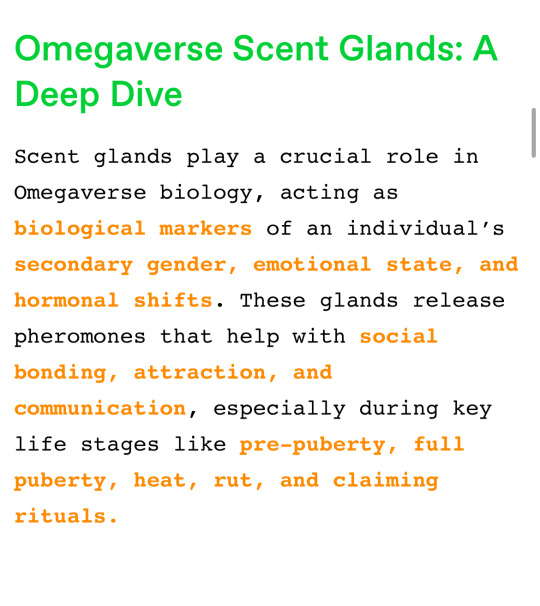
( screenshot above is not mine )
Alphas usually have three scent glands, one on the nape of their neck and one on each of their inner thighs. They produce the “dominant” scent that alphas are known for, which allows them to force an omega, beta, or lesser-ranking alpha to submit to them ( both in a societal sense and for mating ). An alpha’s scent is extremely important to their omega ( if they are mated to one ). Their scent can calm their omega down in an instant and provides safety and security for their omega.
Omegas can have as few as two scent glands or as many as eight. The usual position for these glands are on the nape of their neck, one on each side of their neck, and one on each inner thighs, along with one on each inner wrist. They produce the “submissive” scent that omegas are known for, which naturally catches the attention of alphas. This scent is described as “sweet” or “alluring,” especially when an omega goes into heat, which is when their scent is the strongest and will be almost irresistible to an alpha and can cause any nearby alphas to go “rabid.” HERE is a post about nesting that is canon to my Omegaverse au ( not mine ). Omegas can produce a plethora of soothing scents, ranging from scents used to comfort pups or other distraught omegas, calm down an agitated alpha, or to self-soothe.
Betas often only have one scent gland at the nape of their neck and one on each wrist. Their scent is described as “weak” or “blank.” They produce very few pheromones except the ones used in secondary gender identification, marking them as a beta. They can also produce “safe scents” used to soothe an omega who has been upset by an alpha. Betas are like the gay best friend, in a way, comforting a person after a breakup.

The diagram above is a common example of scent gland placement, but this will vary from person to person.
PACK MARKS are not placed upon any scent glands EXCEPT for the parental or platonic, UNLESS that pack is also a polycule. A packmark are bitten marks that show that a person is a part of a pack, completing the pack bond, and will only remain as long as the pack bond is strong. If the pack bond is too weak or the pack splits up, the mark will fade into a pale white scar instead of a pink mark.
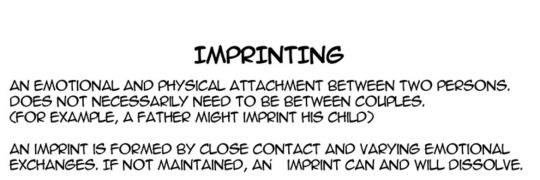
BONDMARKS are placed upon scent glands. They are bitten marks to show that two individuals are mated and bonded to each other in partnership. If the bond becomes too weak, the mark will fade into a pale white scar instead of a pink mark.
A mating/partner bond is a deep connection between two individuals that partially connects their emotions, thoughts, and psyches. It can also be called a soul bond. It is said that bonding with the person you want to spend your life with is one of the single most fulfilling experiences a person will ever have. Emotions are at an all-time high, and both omegas and alphas have described it as finding their "missing piece." Bonding between an omega and beta, alpha and beta, or other less common secondary genders is less intense due to the beta's lack of pheromones and lessened instincts, but is still a very intimate affair.
Pack bonds are not so much finding a "missing piece" as a feeling of deep connection, comradery, and something "bigger than yourself." This will change in polycule packs, when the members are not only packmates but also bondmates.
Note:
If a bonded omega is neglected by their alpha, causing the bond to fade, the omega will suffer detrimental physical and mental effects, ranging from deep depression, low mood, intense anxiety, body pain, fevers, headaches, flu-like symptoms, low energy, increased nesting, and more. The longer the omega is neglected, the more serious the symptoms will become. Severe omega neglect can lead to death and is punishable by court-mandated couples counseling and even heavy jail time if the bond is broken.

OMEGAS
Omegas and omega-subtypes are the third most common secondary gender. About 10% of the population are omegas.
Omegas are physically smaller, weaker, and more sensitive than alphas and betas. They get stereotyped as submissive stay-at-home spouses, but omegas actually have a wide span of individual personalities. Some omegas may be more prone to defensiveness due to instinctive fear of more dominant secondary genders, even coming off as snappy or aggressive. Other omegas fit a softer, more nurturing description, being good with pups and being naturally empathetic and companionable.

PHYSICAL DESCRIPTIONS OF AN OMEGA:
Male omegas are usually between 5’0 and 5’7, weighing roughly between 100–180 pounds. They usually have smaller builds than alphas and betas, though their body types may range from slender, trim, stocky, pudgy, or more. Big eyes and soft skin, as well as the traditional “sweet” omega scent are key ways to spot an omega. Male omegas also don’t produce as much testosterone as male betas or male alphas, leading to less muscle mass and gentler features. They can be extremely agile and fast due to low distribution of body fat.
Male omegas typically have “litters” of 2-3 pups at a time due to their smaller womb size compared to female omegas. However, more than 50% of male omegas who have had multiple pregnancies report that at least one pregnancy produced a non-litter ( singular ) pup.
Female omegas are usually between 4’9 and 5’5, weighing roughly between 100–190 pounds. They most commonly have small, curvy builds, small breasts, and wide hips to accommodate pups during childbirth. They have difficulty gaining muscle mass and usually have more body fat to naturally sustain them during pregnancy.
Female omegas usually have litters of 2-6 pups at a time. Pups from litters may be significantly smaller than a non-litter pup, appearing premature, but with no actual health risk to the newborn. Studies have shown that litter-born pups evolve to have higher levels of competitive, extrovertive, and social behavior in adulthood due to the early bonds they make with their littermates.
Like alphas, omegas have “fangs.” However, their fangs are much smaller, thinner, and more blunt, since they are only used for claiming bites after an alpha has already claimed and mated the omega. Some omegas won’t even use their fangs at all, since marking their alpha is not necessary for the bond to be completed. They will often use their fangs for small nibbles and nips, especially along the jawline or neck, to show affection, companionship, or possessiveness. This is common between both mates and friends.

HEATS:
Heats are exclusive to omegas and omegan subtypes. They usually occur annually or bi-annually, often in the spring and fall. During this time, an omega’s instincts drive them to mate and be knotted by a partner, to breed and produce offspring with them.
Heats last between 1 and 3 days. During this time, omegas will have an extremely raised libido. They may become agitated, defensive, clingy, or anxious. Heats are emotionally taxing both mentally and physically for omegas.
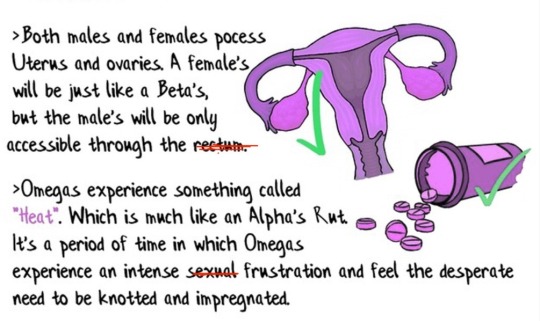
Further information about heats has sadly had to be removed due to the post being flagged. Google can provide further information, since my Omegaverse AU is compliant with canon Omegaverse heat info. Seriously, though, it’s not fair that people post things far more explicit than this and yet somehow this gets flagged???

Betas
Betas and beta-subtypes are the most common Secondary Gender, making up roughly 50% of the population.
They're known for being the bridge between alpha and omega, the in-between "average joes" who are neither dominant or submissive. Betas are known for their level-headedness, loyalty, and trustworthiness, and they can be heat partners for omegas or rut partners for alphas.

PHYSCIAL DESCRIPTION OF A BETA:
Male betas can be anywhere from 5'0 to 6'0, 120-180 pounds, with light to moderate muscles and average builds. They have less testosterone than male alphas but over 30% more than male omegas. Their reproductive organs are the same as male alphas’, but they lack a knot.
Female betas can be anywhere from 4’8 to 5’8, 130-180 pounds, with light to moderate muscles and less fat distribution than female omegas. They usually have larger breasts but narrower hips, as female betas have a lower fertility rate and usually can only have 2-3 pups before becoming infertile. Instead of litters, female betas also usually have one pup at a time. Female betas have the same internal reproductive organs ( uterus, ovaries, ect ) as a female omega, but do not have heat cycles. Instead, most female betas have menstrual cycles of 28-30 days. However, up to 25% of female betas report that they have no menstrual cycles, which lowers their fertility rate further.
Betas lack fangs. They do, however, have canine incisors ( as regular humans in our world do ).
If a beta pairs up with an alpha, the alpha will bondmark them. If a beta pairs up with an omega, they will bondmark them using their canine incisors. The bondmark will lack definition and may scar less perfectly than a bondmark given by an alpha, but as long as the omega’s scent glands are punctured, the bond will be completed.
#omegaverse au#alpha beta omega#abo dynamics#omegaverse#a/b/o#a/b/o verse#a/b/o dynamics#a/b/o au#omegaverse worldbuilding#my omegaverse encyclopedia#questions welcome#Asks are always open#comment below if you have questions#wip#omega nesting#worldbuilding#minors do not interact#minors dni#Omegan#miscecanis#misceverse#misceanimalis#misceblr#Non-traditional a/b/o#Please don’t let this get flagged
56 notes
·
View notes
Text
ALTERFALL: 2024 Recap.

As of last post, ALTERFALL's entire cast of Beta Kids and Beta Trolls have been revealed! Before moving on to any further details such as auxiliary characters (Guardians, Exiles, etc.), Alpha session characters or in-depth looks into the Beta sessions, let's recap - for those who joined partway, or are only joining now!
ALTERFALL is a Homestuck Kidswap/Bloodswap AU in which, due to a single in-universe change, many characters' upbringings are altered due to the landing locations of their meteors being switched. The in-universe event that changes the course of the story and the nature vs nurture approach to changing the characters in their new roles was inspired largely by Inverted Fate, which we definitely recommend to all UNDERTALE fans! Below the cut are some images detailing each character, and at the end a links will be provided to read more about them!
BETA KIDS
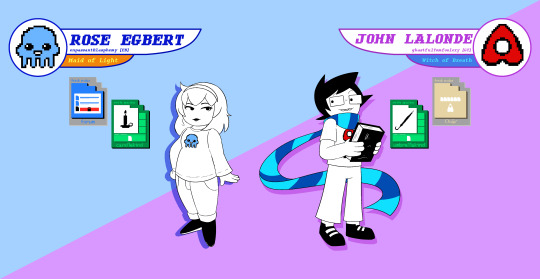
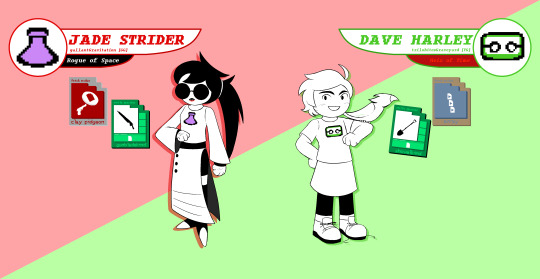
A group of four human teenagers who communicate online after meeting each other in a series of odd encounters. Together, they intend to play SBURB: a mysterious video game entrenched in conspiracies, hoping to dispel the wild rumors breeding in the depths of message boards, or at least to have some fun. Unbeknownst to them, the game truly is the catalyst for Earth's apocalypse, with the four of them being thrust into another world and given the task of creating a new universe.
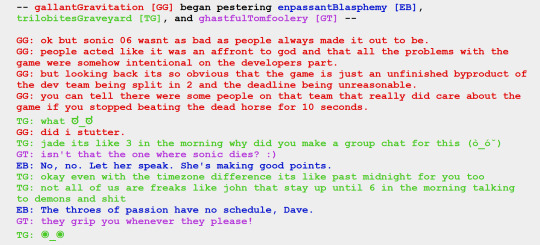
BETA TROLLS
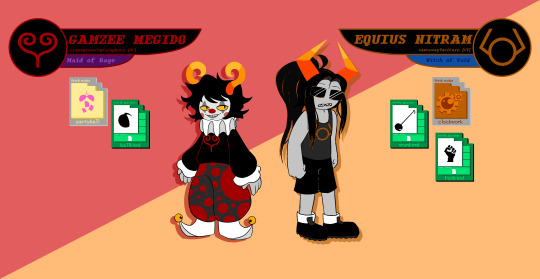
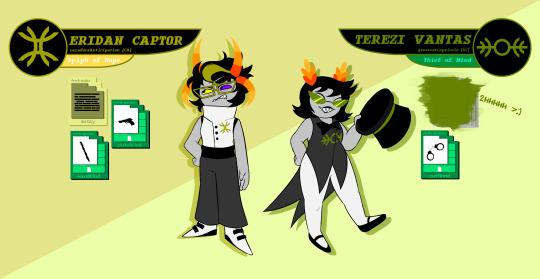
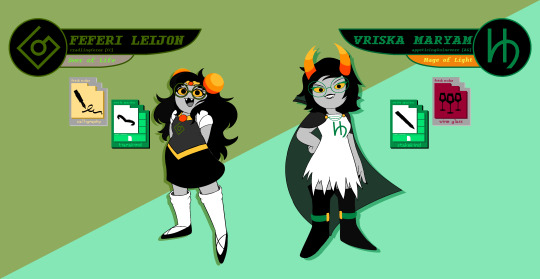
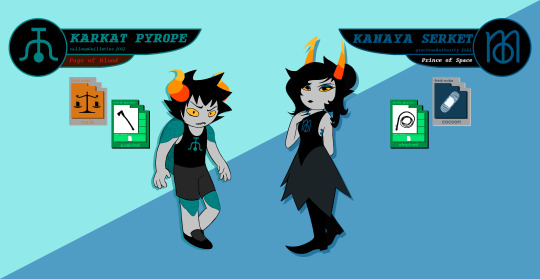
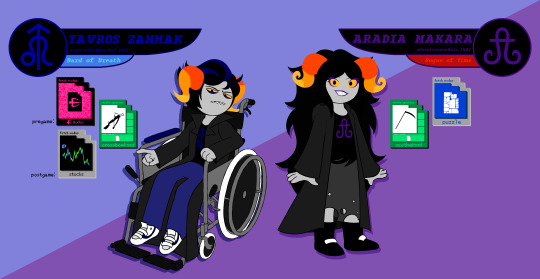
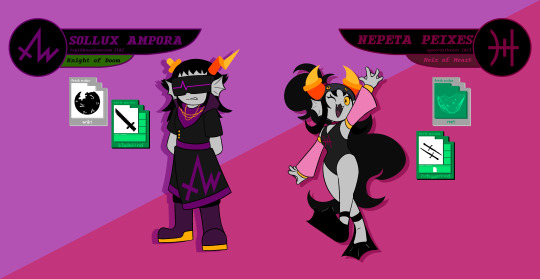
Twelve aliens and previous players of SBURB - or as it is known on their planet - SGRUB. Their gruesome home planet of Alternia has instilled within them all manner of quirks, prejudices and generally colorful personalities (for better or worse), but somehow, against all odds, they managed to succeed in their game and create the universe that birthed humanity. Despite this, these twelve have been trapped in their game session, unable to claim their prize of a new home and festering in their captivity. Connections have been established to the game session of the humans, however, and thus they have gained the ability to send messages to them... At any point in the timeline they so please.

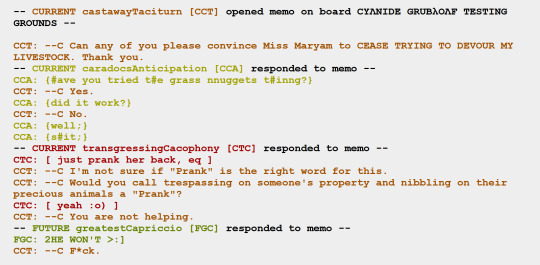
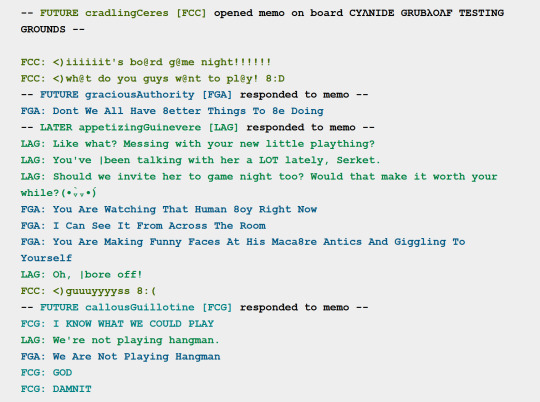
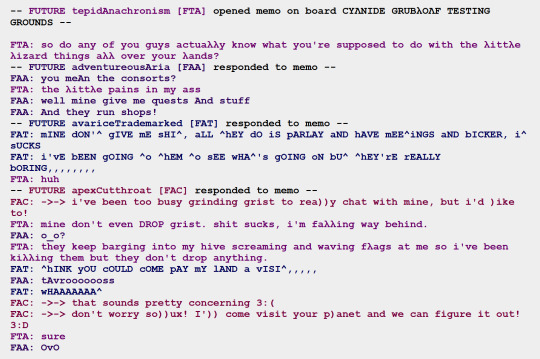
POST LINKS:
Humans: John Jade Dave Rose God Tiers
Trolls: Patrons Aradia Gamzee Equius Tavros Eridan Feferi Sollux Nepeta
Misc: Correction Sprite Art Human Modus Descriptions
Chrono Tag
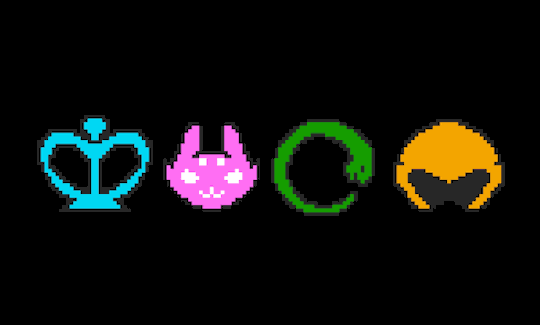
See you soon.
#alterfall#homestuck#rose egbert#john lalonde#june lalonde#dave harley#jade strider#gamzee megido#equius nitram#eridan captor#feferi leijon#terezi vantas#karkat pyrope#vriska maryam#kanaya serket#aradia makara#tavros zahhak#sollux ampora#nepeta peixes
237 notes
·
View notes
Text
Social Media Update: January 6 2022
The first post for the collective in 2022 to their socials was about their first cover of a magazine, Metal Hammer issue 357, that went on sale this day.
Behold, an expression of Worship from the @MetalHammer publication. Consume - http://bit.ly/buyhammer
[X]
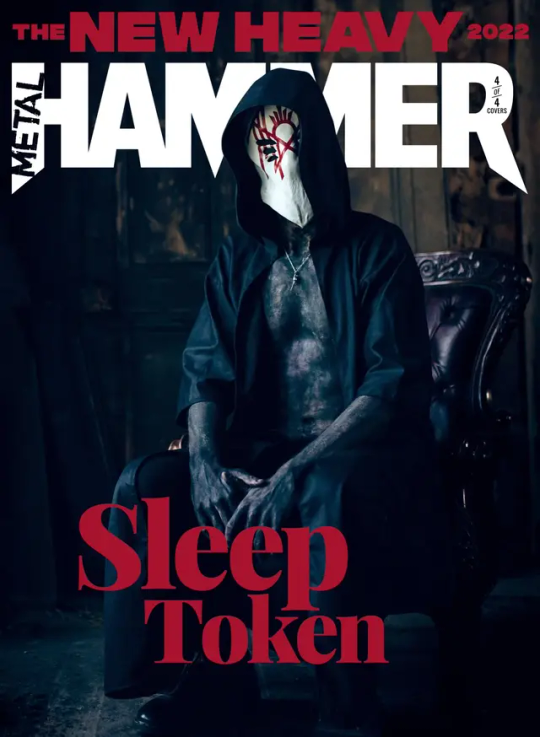
Additional photos from the article, by Andy Ford.
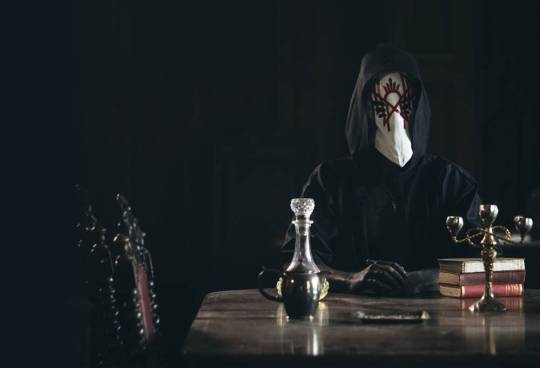


Words by RICH HOBSON. Article can be found here: [Link]
Sleep Token are a Mystery
Anonymous members, no interviews and sold-out shows: Vessel et al have become a modern metal phenomenon. We followed them on tour to try and find out more.
The view from 2022
As Vessel doesn’t talk, we predict the next 12 months on his behalf
What are his New Year’s resolutions?
To ensure a Sleep shrine in every home in the UK, perfect for accepting His offerings. Also for Vessel to kill fewer people using his telekinetic abilities (see: the video for Alkaline) and to use them for something more constructive instead, like whale conservation.
Sleep Token vocalist Vessel stands in front of 1,500 people at Birmingham’s 02 Institute, and the room falls silent. All eyes are fixed on the masked and cloaked singer for a sign – any sign – that might betray some message or hidden meaning behind the band’s mystique.
What’s going to be the biggest thing in metal in 2022?
“We love you!” cries a young woman. Finally, the spell is broken, and the crowd erupt into cheers that Vessel politely acknowledges with a slight nod. Then he moves, and the church-like quietude falls again. Leaning towards the mic, for the briefest of moments it seems Vessel’s five years of almost total silence will end, with Birmingham about to receive gospel from one of metal’s most enigmatic forces. Instead, he clenches his hands together in a sign of gratitude, saying everything by saying absolutely nothing – and everyone loses their minds.
Sleep Token will engage in a holy war with Ghost, ultimately triumphing and ending the line of Papas. Satan will convert to Sleep worship, rendering the whole ‘satanism’ thing redundant. Deicide will become door-todoor missionaries, converting people to the Sleep cause. Black metal musicians will end up switching to country, singing about the good ol’ days when you could burn churches and burn inverted crucifixes into your head.
We’re at the second night of Sleep Token’s eight-date UK tour, and since emerging in 2016, they’ve maintained an iron grip on their anonymity: they obscure their faces, they don’t talk onstage, and they have only ever done one interview – with this very magazine in 2017. The closest comparison is Ghost, but even they had ‘Nameless Ghouls’ who acted as regular spokespeople until Tobias Forge eventually broke cover, a decade into the band. It’s all very impressive – but who the hell are they?
What event or issue will define the world in 2022?
Here’s what we know: in that 2017 interview, Vessel told us that their music is all in service to ‘Sleep’, a mysterious deity whose roots stretch back centuries.
Sleep Token will make history by hosting the first livestream to be beamed directly into your dreams. A bit like with U2 and Apple, the whole thing will cause a massive fuss but ultimately blow over. Mastodon will try to do the same and end up falling through space/ time like a live-action replication of Crack The Skye.
“How we got here is as irrelevant as who we are – what matters is the music and the message,” they said. “We are here to serve Sleep and project His message.” And… that’s about it. Cheers for the insight, pal.
Despite – or perhaps because of – their secrecy, Sleep Token are fast becoming a cult sensation. While the lore is centred around Vessel, Sleep Token describe themselves as a collective, suggesting a collaborative effort between seasoned musicians, all feeding into the art. That may go some way to describe their fluid approach to genre, pulling elements of everything from tech metal and alternative to pop and R&B – part of a new breed of heavy bands who aren’t afraid to embrace multiple genres, as well as nontraditional ways of working.
In 2019, they drip-fed a series of singles that eventually became their debut album, Sundowning, rather than going ahead with a straightforward release. Even though they couldn’t tour during the pandemic, last September’s This Place Will Become Your Tomb charted at No. 39 in the UK, and this current run will conclude at London’s 2,000-capacity Shepherd’s Bush Empire. It’s no small feat.
“Sleep Token are an expression of where metal is in the 2020s,” says Ihsahn, co-founder of black metal legends Emperor and pioneering avant garde solo artist, who’s on the same label as the collective. “From the first time I heard them, I was completely intrigued – the way they mix modern metal elements with very dark moods, but also very clear, modern R&B-style production values.”
Sleep Token are by no means the first anonymous collective in metal, but their symbol-emblazoned masks, dark body paint, and use of everything from Nordic runes to Hindu symbology in their artwork have piqued the curiosity of metal fans and fellow musicians.
“It’s similar to what we had with the black metal scene, with the masks and mystery that helps to raise it all,” Ihsahn explains. “Emperor wouldn’t be where they were without that theatricality, because we needed to do something to distance ourselves from the spotty teenagers we were!
“It creates a clear distance and space between the art and the artist,” he continues. “I’ve always appreciated artists who created that distance – going back, you can watch all these interviews with David Bowie but it never feels like you knew him. The art he created was an offering and you just had to try to understand it.”
Of course, with Vessel it’s even more difficult. Our attempt to get answers in 2017 was like grasping at mist: when we asked why they wished to remain anonymous, Vessel turned the conversation towards what he thought was truly important – the art itself. “Our identities are unimportant,” he said. “Music is marketed on who is or isn’t in a band; it’s pushed, prodded and moulded into something it isn’t. Vessel endeavours to keep the focus on His offerings.”
When asked what the future held, Vessel simply replied: “Nothing. Lasts. Forever.” Does that mean there’s a time limit on the band? What the fuck is going on?
It’s tinfoil hat time. Outside of live performances, Vessel has only appeared in music videos. His first onscreen appearance came as a shadowy, grasping figure in the 2016 video for Thread The Needle, before appearing maskless in the 2017 video for Calcutta – albeit with Slipknot/Before I Forget style editing that only showed his mouth, cheek and eye. He’s become more prominent in recent videos – even telekinetically taking out a room of hazmat-suited goons in the video to Alkaline – but still no obvious, overarching narrative has emerged.
Elsewhere, his mask has made its own separate appearances. In the video for Fields Of Elation it floated free in a body of water, and in Nazareth it appeared standing alone in the video’s final moments, before appearing in blink-and-you’ll-miss-it moments in Jaws, where it’s worn by the video’s star.
Which raises the question: is Vessel the man behind the mask, or something the mask brings forth?
Sleep Token’s acolytes have been searching for clues. In a Discord server set up by Coventry-based fan Chris, they pore over the band’s lyrics, album artwork, music videos and merchandise in an attempt to decipher hidden meanings, like a metal take on The Da Vinci Code. “It was actually through Metal Hammer that I got into the band,”
Chris tells us. “Reading the interview with Vessel on the website, I wanted to find out more. I took to Reddit to see if there was a community for the band and at the time there wasn’t, so I decided to create it.”
Now numbering more than 900 members, the group have become adept at deciphering codes left by the band. They discovered that a string of numbers featured on a t-shirt design were coordinates for a ‘whale fall’ – an event where a whale’s carcass falls to the ocean floor and becomes a source of nourishment for an entire ecosystem. When This Place Will Become Your Tomb was released, Benjamin, one of the admins, even took on the semi-joking role of Keeper Of The Lore, maintaining and steering discussions for each new song.
“I loved the hidden identities and world-building the band was presenting,” he explains. “There was a whole experience outside of just the music. The new album features heavy imagery of a decomposing whale and the animals that would feed on it; a representation of life in death –a topic lyrically discussed by Vessel frequently – and eternal recurrence.”
The Discord continues to provide fascinating insights into what the band may – or may not – be exploring through their art. But without any form of ‘official’ statement on their theories, and with a potential fixed end point for Sleep Token, couldn’t the fanatics be setting themselves up for disappointment down the road?
“Nothing lasts forever – until then we Worship,” Chris says matter-of-factly.
Aside from discussions on mythology, the Discord has also become a social club that binds people together. “The Discord community is amazing,” says New York-based fan Veronica, aka BluKittie. “There are people from all over the world and we share the same love and passion for the band. We are always there for each other. Last year my father passed away and the members of the community helped me through that rough time, and still do. I am just happy to have found friends there.”
An hour before Birmingham’s 02 Institute opens, the queue is already snaking down the street as far as the eye can see.
At the band’s request, we’re not allowed backstage lest we see their faces, but we do speak to their support act, solo artist AA Williams. Like Sleep Token, she’s found an audience with metallers even though her music spans alternative, pop, soul and metal –a sound we’ve previously tagged as ‘death gospel’.
“I think we work pretty well together,” she says. “It’s great to see an artist who is able to explore both pop and really heavy music without the need to hold back or overcompensate on either element. The shifts in dynamics really come to life live, and their crowd utterly lap it up – it’s like going to church.”
Are there any difficulties that come from playing with such a secretive act? Has anyone tried to get her to reveal Sleep Token’s identity? “Well, it’s not like we’ve had to sign NDAs or anything,” she says. “At the same time, you do want to make sure you’re not impinging on their privacy, and respecting their choice to present their art in a particular way. If anyone asks who they are, I think I’ll make up a celebrity – it’s Robert De Niro. Next question – ha ha ha!”
Tonight AA commands rapt attention, but there’s no competing with the headliners. All chatter is silenced as the room plunges into darkness. Moments later, Vessel strides onto the stage alone to cheers of approval, his mask the only thing visible against now-muted lighting. He tinkles the ivories for Atlantic and the crowd are soon singing along to every word, even though the album has barely been out two months.
AA WILLIAMS
For 90 minutes, Sleep Token hold attention in a way that defies logic. How can a band that don’t speak be so damned expressive? Compared to the stagecraft of bombastic arena bands such as Iron Maiden or Sabaton, Sleep Token are low key, but Vessel radiates gravitas, his twisting and grasping movements bringing to mind the theatrics of interpretive dance, where each flick of the wrist could be conveying some hidden meaning. The fans are utterly enraptured, moshing and singing along with religious fervour, lending credence to the band’s social media descriptions of their shows as ‘rituals’.
As it was in Birmingham, so it is in Glasgow, Sheffield, Dublin and beyond. By the time the tour arrives at London’s sold-out Shepherd’s Bush Empire, it’s clear that, much like Ghost before them, Sleep Token are fast outpacing their status as a cult phenomenon, smaller academies no longer able to contain their rapidly growing fanbase.
If Birmingham was about reverence, London is outright revelry – an irrepressible crowd engaging in a bacchanalian frenzy that has little to do with the extortionate bar prices and everything to do with the explosive performance unfolding onstage. And then, a couple of lads start Cossack dancing in the middle of a circle pit. Sleep help us…
Not to be outdone, Sleep Token bring out their own dance troupe for Fall For Me. Not that they need any help capturing people’s attention: here, Sleep Token are preaching to the converted, a cult threatening to spill over into the mainstream.
No one knows what direction Sleep Token will go in next, and it’s not as if they’re about to tell us. But then, that’s how things have always been with the band – each release a mystery that fans can’t wait to unwrap. “When I heard the second album, there was no indication of where they were going, so in my mind it just had so many seeds of development,” Ihsahn says. “There’s more maturity and there’s clearly something they are building towards, though exactly what that is, is impossible to say…”
Perhaps the stock answer from Vessel, five years on, would still be “nothing lasts forever”. Will they push their sound even further? Will they start conducting interviews? Will they ever unmask? Right now, anything is possible – and that’s what makes Sleep Token so exciting.
#sleep token#sleep token archive#social media updates#metal hammer issue 357#sleep token focused articles
55 notes
·
View notes
Note
I have a question, my friend: aside from their perceived ability to prolifterate, why aren't species like the German cockroach and other ""nuisance"" ""pest"" bugs more utilized as food for pet inverts? Obviously not necessarily wild caught ones, as you can never guarantee a wild caught's safety for your bug. It just seems like if they're really really easy to breed, aside from not letting them out, they seem like a GREAT idea for an easy-keep prey item?
I've never looked into it, but I would say a big factor is that there's a very high chance they will escape their containers at some point and most people would not be cool with them establishing themselves in their house. Common feeders like dubia roaches won't infest a home if they escape, and dubias are just as easy to breed.
91 notes
·
View notes
Text
already plotting my next ideal dream aquarium setup…. wanna do a species tank for a red wennerae mantis shrimp, with lots of macroalgae and maybe a lil bit of soft coral/sponge/gorgonians for variety, and maybe even some more fun sessile inverts if she behaves herself (like a christmas tree worm rock or some nems) and a saltwater molly breeding setup for feeding her with. i have a 3d printed articulated whale skeleton that i wanna use as decor for it to set up a whale fall-esque type aquascape. and i will name her lizzie. because i am normal and sane.
23 notes
·
View notes
Text
Kabbalah in the Worldbuilding of Genshin Impact; Part 3: Very Impure, Very Sinful

Written by Sabre (@paimoff on twitter) and Schwan (@abyssalschwan on twitter)
The Origin of Evil
In earlier parts of this theory, we've discussed how the elements of Teyvat and their ideals are similar to the sefirot of Kabbalah, as well as the implications of the similarities between Descenders and the Kabbalistic Primordial Man. In this section, we'll be discussing how the metaphors used to describe evil in Kabbalah are made literal in Genshin, specifically in the form of the Gnoses and the Heavenly Principles. We’ll also be connecting the Traveler’s role as RPG ProtagonistTM to the Kabbalistic concept of Tikkun Olam (repairing the world) and how that relates to their role in the good-evil duality.
When it comes to the concept of evil in kabbalah, there are generally two perspectives considered: 1) evil is the result of an imbalance in the dichotomy of divine mercy vs divine judgment, and/or 2) the existence of evil is an inherent part of creation that can be affected by the actions of humans.
The Zohar, a foundational text of Jewish Kabbalah and massively influential on Western esotericism, details several explanations for the origin of evil. This theory does not contain a comprehensive analysis of the philosophy of evil in Kabbalah, but we’ve tried to at least mention or summarize the core concepts that can be tied directly into discussion of Genshin’s worldbuilding.
The primary explanation in the Zohar is that evil originates in the sefira of divine judgment if it is not counterbalanced by divine mercy. This creates a parallel but mirrored/inverted system of the sefirot, called the Sitra Achra, which we will refer to with the literal translation “Other Side”. This dimension is associated with death and anger, and a few other unique traits we’ll explore later on. It’s important to note that according to this perspective, the existence of evil is actually a necessary part of the divine plan for the world - some of the commandments in the Torah (Jewish law), or even regular human activities like sleeping, are described as actions that ‘appease’ the “Other Side” and keep the balance between good and evil forces in the world. The Zohar even goes as far as to suggest that the “Other Side” can function as a ‘test’ for the righteous: In order for someone to be fully righteous, they must descend completely into the realm of the “Other Side” and resist all their temptations and then emerge pure. Those who fail are doomed to become breeding grounds for demons. Interesting.
The Husks in a Nutshell
The Zohar also introduces the concept of the klippot, literally husks, shells, or peels . The name Qlipoth, which players of Honkai Star Rail might be more familiar with, is just another spelling of the same term.
The Zohar’s conception of the sefirot is like a nesting doll: the sefirot are one inside the other, like concentric circles, and the klippot are the shells each sefira makes around the one inside it, as illustrated in the drawings below, where each ring or square represents one of the sefirot.

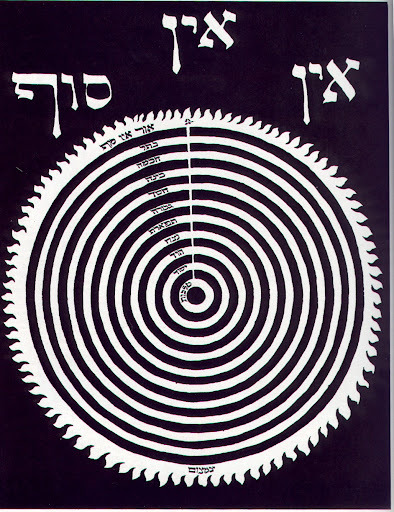
This ties in to another one of the Zohar’s explanations for the origin of evil: evil has always been mixed in with the sefira of Keter, the first to be emanated, and in order for reality to be formed, the evil had to be purified out. This was done by repeatedly creating worlds and destroying them, until the creative divine energy was purified. Think of it like when you’re washing something you’ve dyed, and it takes multiple washes for the dye to stop bleeding.
This process leaves behind “shards” of evil, which become the foundations of the dimension of evil, the “Other Side”. The Zohar names some of the klippot as direct counterparts to the sefirot, giving them equivalent roles in their respective dimensions, but there is no consistent or complete description of all the names or comparisons.
Similar to the process of creation and destruction described above, Rabbi Isaac Luria (very influential Kabbalist in the 16th century) described a process where there are multiple iterations of the creation of the world, resulting from the dilution of divine energy as it is emanated into the void where reality is created. (For a more detailed explanation of this, check out Part 2.) Luria compares the sefirot to vessels filled with divine light, and the farther these vessels get from the source of the light, the weaker they get. Eventually the vessels shatter and form the klippot, which here are technically fragments of the divine and not inherently evil. However, unlike the sefirot that can balance each other, these fragments are isolated and intense attributes of the divine that eventually become evil and demonic.
In the context of Genshin, the klippot take the form of the Gnoses, reflecting their role as both remains of evil and fragments of the divine isolated from the source.
Demons and Dead Descenders
Back in Part 1 of this theory, we briefly discussed the implications of both the inverted Irminsul and the Demon Gods, or Archons, in the context of Kabbalah. We hypothesized that Teyvat is in the dimension of evil, aka the “Other Side,” and the Archons have demon names to indicate their alignment with each of the evil equivalents of the sefirot: the klippot. There is no standardized list of demons associated with the “Other Side,” so we think that they are using the Goetic demon names instead, like some historical sources have done in their incomplete lists.
We also suggested that the Gnoses themselves could represent the klippot of each element, the “shell” around the sefirot. This was based on the information we knew about the Gnoses at the time which was basically that:
a. It is an “internal magical focus that resonates directly with Celestia itself,” and represents the archon’s status as one of The Seven (Archon Quest, Prologue, Act III, Ending Note). This may be related to Zhongli’s concern that giving up his Gnosis will mean that he cannot defend Liyue anymore (Zhongli Character Stories: Gnosis)
b. It can gather elemental energy for the Archon, presumably acting as some kind of amplifier, given that the Archons have elemental abilities without a Gnosis (Nahida Character Story: Gnosis). This is presumably how the Akasha (and the Oratrice) was able to be powered by the Gnosis, and how Nahida was able to use the power of two Gnoses to access Irminsul and delete Rukkhadevata, something she could not do with her own power (dendro+electro amplifying reaction indeed).
The Fontaine Archon Quest and subsequent Neuvillette character stories introduced two new crucial pieces of information that cemented the role of the Gnoses in this theory:
a. The Gnoses are the remains of the Third Descender, and since they are remains, they are cursed. Skirk even says that the Gnosis “smells” “very similar to a god's ‘curse’.”
Skirk: Regardless, you should probably get rid of objects of "misfortune," to prevent any disasters from befalling you.
Skirk: To live is in itself a blessing. But once a person dies, the bonds he once had with this world shall all turn to curses.
b. The Primordial One was wounded in the “great war of vengeance” (probably when the Second Who Came arrived) and couldn’t “suppress the original order” of the world anymore. They and the “one who came after” created the Gnoses from the Third Descender and used them to “subdue and control the resentment and loathing of the world.” This seems to have created a new order to the world, where the remaining primordial “fragments” were destroyed, and humans gained the “seven remembrances.” (Neuvillette Character Story: Vision). This is implied to be related to the Archon War and to humans receiving Visions, which is described as a “shattered shard” of an Archon’s authority.
With this updated information, we have more evidence for our claims that Teyvat is in the realm of the “Other Side,” and that the Gnoses are the klippot. Here we compare key traits of the Gnoses and the Kabbalistic metaphors used for evil:
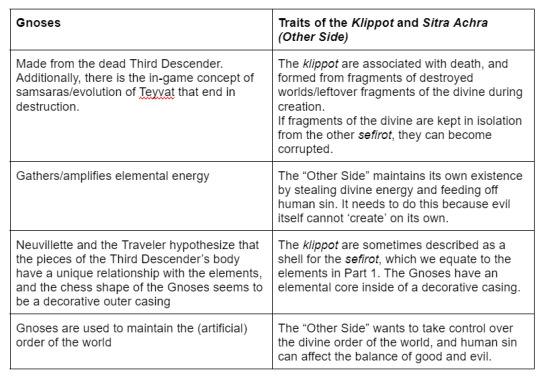
While the Gnoses and the “inverted” world of Teyvat are certainly the most overt references to the klippot and the “Other Side” in Genshin lore, derivations of these concepts are sprinkled throughout the worldbuilding in the form of repeated references to ‘shards’ and ‘husks’ of power and will. In the next section, we’ll go through two primary categories where the klippot of Genshin can be found: Death and the anger it leaves behind, and judgment, which includes the concept of sin in Teyvat, and speculation about how the Heavenly Principles turned Teyvat into the “Other Side.”
Rest in Pieces: Death and Anger
As you may have noticed, dying in Teyvat is not exactly straightforward. Death is meant to be a sort of recycling/reincarnation process via the leylines, but it seems like there are infinite exceptions to this rule. Hilichurls are cursed to never be able to enter the leylines, and thus are never able to truly die. When gods die, they can stick around indefinitely as corrosive and resentful energy (like Yaksha’s Karma and Inazuman Tataragami), or their remains can be used to permanently change the environment, like Rukkhadevata creating the Harvisptokhm out of Egeria’s remains to seal Tunigi Hollow. God-like individuals have also ‘died’ after being split in pieces, and those pieces contain some aspect of their will or consciousness, like Liloupar or Hermanubis and his Ba fragments. The Ba fragments are even associated with specific traits like the sefirot are: Sethos specifically mentions might and glory, which could correspond to the sefirot of Gevurah and Hod respectively. Both these and the resentful energy of things like the Tataragami can influence the actions of humans who come in contact with these fragments and remains.
The will of more ordinary people can also remain after death: the Shadowy Husk enemy descriptions call them “nothing but a husk,” and that “the long years and a curse seems to have robbed them of their reason and memory. Now, all that remains within that armor is the will to "fight for something, someone, and some matter."”
All shall decay in the end, and this is all that is left of the Black Serpent Knights amidst the merciless march of their sins, curses, and time itself.
We also have instances where a powerful being’s sacrifice provides the power for an ‘impossible’ event to occur: the Goddess of Flowers using her body as a conduit to give Deshret access to forbidden knowledge, or Sybilla sacrificing her life to create Phobos. Sybilla, who was likely also a Seelie, is described as being from the land of the dead - more on Seelies later. And most relevantly, we have the death of the Third Descender being used to create the Gnoses.
Logically, this death-associated release of power makes sense In a world that is also the “Other Side.” But it also seems to be a double-edged sword: just like how the order of the world itself is held together with the Gnoses sourced from death, the death of other powerful beings can destabilize it.
And speaking of the Gnoses - how is it that ‘death’ energy can be used to channel elemental energy, which should belong to the sefirot? As we mentioned earlier, that’s because the klippot and the sefirot are derived from the same divine source material - at their core, the realm of the divine and the realm of the demonic are the same. The distinction between these powers in Genshin is their source: are these the true elemental powers original to this world, or is this the power stolen by the Heavenly Principles?
Teyvat has its own “laws”: Judgment, Sin, and Curses
Earlier we mentioned that the Zohar’s primary explanation for the origin of evil is an excess of divine judgment. In Kabbalistic thought, divine judgment refers to the setting of limits during creation - without it there would be no distinction between anything and the world would just be an everything soup. For more on this idea and its usage in the Fontaine AQ, check here. When it comes to the human expression of this idea, “limits” would be equivalent to the concept of laws, both natural (like physics) and legal (like the concept of social contract).
The Heavenly Principles are thought to be the highest power of “law” in Teyvat, described in the Scroll of Streaming Song as “the universal law created in heaven, the divine laws established in the beginning.”
Nahida also tells use that the Gnoses represent the laws of the Heavenly Principles:
Nahida: I'm sure you remember the entity that changed your fate — the Heavenly Principles. Nahida: In fact, the Heavenly Principles has been quiet since the Khaenri'ah disaster five hundred years ago. I used this point as leverage against The Doctor. Nahida: I told him that the Heavenly Principles may be awakened if I destroyed a Gnosis. Although it was just a bluff, he still fell for it. Nahida: I assumed that the Heavenly Principles wouldn't just stand by and let such extensive damage to its "laws" take place.
What do these laws entail, exactly? Rukkhadevata in Scroll of Streaming Song explains:
"One may only bow down and worship Vaana of the heavenly spirits — no arrogation, deception, or trickery is permitted." "If one dares to imitate the forbidden arts, only calamity awaits at the edge of divine knowledge.”
As expected, these “divine laws" include definitions of sins, and conveniently for us, these sins tend to be punished with curses, yet another misfortune associated with the klippot.
There are three* curses specifically associated with the Heavenly Principles:
The “curse of the wilderness” which turned non-pure-blood Khaenriahns into hillichurls (but may be older than the Cataclysm considering hillichurls have been around since before that time and there are other references to humans turning into various monsters that aren’t associated with the Cataclysm)
The curse of immortality put on pure-blood Khaenriahns during the Cataclysm
The Seelie curse, which has multiple variations: a. Arama says the Seelies were cursed to become “empty husks” if they fell in love with a human. The curse would make them lose their intelligence and their bodies would shrink, becoming the little treasure Seelies found in exploration b. Wolfy in the Imaginarium Theater talks about the Boar Tribe who were forced to place parts of themselves on a scale, and then lose those parts of themselves, as a punishment. The description of what happened to these boars sounds a lot like the Seelie curse. Wolfy: Those boars who placed their heads on the scales became wolves, lizards, and snakes, leaving only their strength. Those who offered their muscles became rabbits, leaping three paces to a bound, instinctively guiding people to treasure.
*Paimon voice* “Maybe it should be called the rule of four!”: While we don’t know yet if this is associated with the Heavenly Principles, Skirk references a god’s curse, which in context seems to be related to the Gnoses and the fact that Gnoses are the remains of a dead Descender.
In summary, the Heavenly Principles, their “divine laws” and corresponding curses and punishments are the Teyvat equivalent of the excessive divine judgment that leads to the formation of the “Other Side”. According to the Zohar, the “Other Side" and the klippot sustain themselves through stealing divine energy and feeding off human sin. We’ve already discussed how the Gnoses are the means for stealing divine energy, so how does human sin play a role in this equation?
The Sinners Are All That's Left
After the war with the Second Who Came, and the Seelies were cursed, the Heavenly Principles established the order of Teyvat using the power from the death of the Third Descender: the Gnoses. They then had the gods of each nation fight to the death for the chance to win this power and become representative of their “law”, creating resentment in many places across Teyvat. Given what we know about the klippot, we must consider the Archon War as the Heavenly Principles creating strife and death to power themselves enough to maintain the order of Teyvat.
A similar system is presented in one of the in-game novels, Princess Mina of the Fallen Nation, which tells the story of a princess prophesied to bring destruction. Her nation is plagued with wars due to “Nakura’s Hex,” which drains the life force from people and the environment to strengthen the soldiers, who then in turn, continue fighting to be the most powerful, which leads to them draining more life. In the fifth volume, Mina and her slayful samurai bestie arrive at the Sky Tower, where they meet some priests and learn the truth of their world: Nakura’s Hex was originally created to preserve the “slowly declining” world. Mina learns that she must sacrifice herself, destroy the current world, and use the stored up power from Nakura’s Hex to create a new one. It’s left ambiguous if she succeeds.
If the Heavenly Principles are able to gain power from wars and death, then they should also be able to gain power from sin as well. And lucky for this theory, we just finished the Fontaine region, where this very concept was explored in the Archon Quest. In order to collect enough power to destroy her Archon throne and return the Hydro authority to Neuvillette, Focalors created the Oratrice. The Oratrice pronounced verdicts during court cases and converted the people’s belief in justice into Indemnitium, which was then used to power Fontaine. In reality though, most of this power was stored up to eventually kill Focalors. In other words, the crimes and well, sins, people committed against each other generated tangible power that could be used by a god.
In this context, the fact that the title “Sinner” is associated with the cataclysm and Khaenri’ah, and the recent reveal that the Five Sinners split a “world-shattering” Abyssal power between each other become more significant.
Considering all that we’ve discussed regarding the use of death as a power source in Teyvat and its connection to the Heavenly Principles in their capacity as the Other Side, we are left wondering if the Sinners attempted their own Third Descender moment. In the context of what we’ve theorized about the Primordial Human Project previously, Rhinedottir’s role as a Sinner feels particularly relevant here. Whatever it was exactly that the Sinners were trying to do, their power definitely was “world-shattering,” since 500 years later Teyvat is still recovering from their and the Heavenly Principles’ actions during the Cataclysm.
And speaking of the present day problems of Teyvat, we are now ready to talk about the role the Traveler plays in the interplay between the Heavenly Principles and the original order of Teyvat.
The Repairing of a World More Broken Than Elon’s Twitter
Ever since the Traveler woke up in Teyvat they have been helping everyone around, whether it’s finding lost pets, defeating evil dragons, finding cures for the sick, cleaning buildings or leyline disorders, maybe defeating another dragon… whether big or small there’s no feat that’s beneath our protagonist. That’s what the heroes do right? Well yes. But it also has a deeper, Kabbalistic significance.
Lurianic Kabbalah builds on the Zohar’s idea that human actions can either strengthen or appease the klippot by proposing there are also specific actions humans can do to have a positive influence on the world. There are two states the world can exist in: Tohu (chaos), where the sefirot are unbalanced, and Tikkun (repair), where the sefirot are harmonized together. Luria taught that humans could contribute to the “Repairing of the World” (Tikkun Olam) by strictly adhering to the religious laws of the Torah. With time, the idea that humans can contribute to the improvement of God’s world by performing acts of kindness and altruism has become mainstream in Judaism, and in the modern day, Tikkun Olam has come to refer to the value of social justice. By performing these “repairing” actions, the Divine Energy that’s “trapped” inside the klippot is released and returns to its rightful place, contributing to the balance and harmony of the world.
Similar concepts are referenced directly in Genshin: In Chinese, the Heavenly Principles are Tiānlǐ: “Heavenly Order.” Li refers to a concept in Confucianism that literally translates to ‘rite,’ and refers to specific ritual actions that connect human action to the harmony of the greater order of the universe. Li is not necessarily religious rites as it also includes “basic” human interactions with each other and nature.
Another similar idea is the alchemical As Above, So Below, which is generally interpreted to refer to either the movement of the celestial bodies affecting events on Earth, or the correspondences between the macrocosm and the microcosm (the human being). You may recognize this second idea from Part 2 of this theory.
In other words, this means that the actions that humans take in the material world can have a direct impact on the spiritual world (in Judaism) or on the larger movements or changes of the rest of the universe (Li and alchemy). These concepts are all relevant in our discussion of the role of the Traveler, but here we will also be using it to illustrate how the Heavenly Principles have control over Teyvat.
The concept of As Above, So Below has been mentioned in the context of the Heavenly Principles in Scroll of Streaming Song:
"O wise Princess, if your wisdom is truly as the legends of the people say," "Please answer my second riddle as you did the first." "What rises from the earth, then descends from the sky," "No one has seen it, yet it sees all," "As above, so below, and as at the bottom, so too, the top," "Yet only top to bottom may be, and never bottom to top?" That princess of (...) answered thusly: "You speak of the universal law created in heaven, the divine laws established in the beginning." "No one has seen the eternal law, yet it governs all.”
The Goddess of Flowers is implying here that technically this principle should apply to the Heavenly Principles and their laws, but in the order of Teyvat, only the law can govern the “below,” the world, and the world can not reciprocate their influence on the “above.” This would mean that human action on Teyvat actually does not have an effect on the “sky,” which is the spiritual realm. In the Flower of Paradise Lost artifact lore, she says that the "master of the heavens, consumed by fear for the rising tide of delusion and breakthroughs, sent down the divine nails to mend the land, laying waste to the mortal realm..." This suggests that the sealing off of the connection between Teyvat and the heavens is the result of the Heavenly Principles’ fear of the power of the “invaders” and the effect they and other humans could have on them from the human ‘realm’ of Teyvat.
More simply, this means that the Heavenly Principles are actively preventing the humans of Teyvat from performing the “Repairing of the World”.
The (semi)literal translation of Zhongli’s burst voiceline also references this, but in connection with Li and Confucianism, rather than alchemy: “Heaven moves; all follows.” In this scenario, he, as the Archon, has the authority to act as the executor for the Heavenly Principles’ law (Tian Li), and invokes “heaven” to set a limit/boundary. You can even see this illustrated with how his burst stops the enemies from moving, as he restores ‘order’. (Credit to Cristal Marie for this insight)
The one exception to the restriction set by the Heavenly Principles seems to be the Traveler, whose helpful acts are excellent displays of “Repairing the World”: Indeed, while Traveler was initially just showing their good nature, many of their actions have contributed to restoring a balance to a Teyvat that seems to be in a state of “Tohu” (chaos).
Examples are varied and extensive, but we can categorize Traveler’s actions as follows:
Returning things to their rightful place: repairing the Statues of the Seven by returning the Oculi, helping the Seelie return to their courts.
Repairing and balancing Leylines: cleansing Leyline disorders at places like Chenyu Vale, the different islands of Inazuma, cleansing leftover Forbidden Knowledge at Sumeru.
Aiding people and living beings: from the Aranara and Melusines to Scaramouche and Dvalin, ill or struggling NPCs, lingering ghosts, etc
Defeating and suppressing evil forces: Osial, Beisht, an eroded Azhdaha, the Thunder Manifestation, the Tatarigami at Yashiori, different agents of the Abyss Order, the All-Devouring Narwhal.
Performing appropriate rituals: the Funerary Rites for the “passing” of Morax, the Rainjade Rite at Chenyu Vale, the Festival Utsava, the Watatsumi Goryou Matsuri, the Sakura Cleansing Ritual, etc.
All this repairing, cleansing, returning things to correct places and balancing elemental energy fits with the Lurianic description of how “Repairing the World” is achieved.
In the first part of this theory we compared the Kabbalistic sefirot with the seven elements of Teyvat, as different “colors” derived from elemental energy. We also mentioned how the famous array of the Sefirot in the “Tree of Life” is an idealized state: the truth is that they won’t be arranged in such a balanced way until the coming of the Messianic Age, and that will only be achieved once the repairing of the world is complete. In this context then, the Traveler’s actions should be accelerating the arrival of this ideal state.
But… isn’t Teyvat the world of the “Other Side”? Who exactly is the Traveler aiding with their actions? Aren’t they strengthening the klippot by maintaining the order set by the Heavenly Principles, who have been accused of being “usurpers” chaining the world to an unnatural order? Or is the Traveler actually reversing this and returning the world to its natural state?
There are a few instances when we are led to doubt that the Traveler is doing the ‘correct’ thing as they purify/restore places in Teyvat. During the Chenyu Vale world questline, Lingyuan says that the adeptal energy the Traveler gets from Fujin has the power to “suppress nature” and that their efforts to perform the Rainjade Rite go against nature as it is intended to be. She also makes a cryptic comment about how humans used to be part of nature, but are no longer. This may simply refer to how humans affect the world around them, or perhaps it’s meant also as commentary on the Traveler’s actions and the way they are generally considered to be positive and restorative.
In this case, if the Traveler is doing wrong, could it be that the “true Messiah” is out there, being labeled as a “sinner” for trying to release Divine Energy from the evil grasp of the klippot?
After all, we know someone who fits that description: the Traveler’s own sibling.
Purification through Sin: how the Abyss Order are the good guys akshually
There was actually a movement in Jewish mysticism that believed that doing exactly the opposite of what Luria advised (following the laws of the Torah) is what would achieve the complete repairing of the world. This movement started in the 17th century, in the Ottoman Empire, when a man named Sabbatai Zvi claimed to be the long awaited Messiah. It wasn’t the first time this happened, indeed Christianity arose from one of those very claims.
The Sabbatean movement, like many before them, drew criticism from more conservative Rabbis particularly due to the seemingly unstable behavior of their leader: sometimes boldly going against Jewish law, other times falling into periods of melancholy that were “unbecoming” of the Messiah. The breaking point for the detractors of Sabbatai Zvi was his public conversion to Islam after being threatened with torture and execution by the Ottoman authorities, effectively becoming an apostate to the Jewish faith. Despite this, Sabbatai Zvi had a big following, and his conversion didn’t deter them.
What’s relevant about this Messianic claimant movement is that much of the fuel for its credibility was based on Kabbalistic thought. Nathan of Gaza, an accomplished student of Jewish theology, was the first believer that Sabbatai was the real Messiah, and from then on used his deep knowledge of Lurianic Kabbalah to argue why Zvi’s questionable actions were what had to be expected from the Messiah, including the most serious sins. Much of the reasoning for this is explained in a text that is still polemical today: the Treatise on Dragons.
Nathan argued that even though the entirety of the created universe was emanated from Divine Light, that doesn’t mean all of this divine essence was used up: there was a good amount of Divine Light that wasn’t involved in creation, and in a way “didn’t desire” to become created matter. When the endless Divine Light “retracted” to make space for the future world, the leftover “Void realm” had remnants of Divine Light that didn’t want to be part of creation, and were even hostile to it. Afterwards, Divine Light entered the Void in a “vertical line”, penetrating it and kicking off creation, including the subsequent shattering of the vessels mentioned earlier. Eventually, the shattered fragments of the vessels and the hostile remnants of Divine Light formed the realm of the “Other Side.” So now, the upper levels of the Void is where the created world is located, and it’s also the realm where humans can aid the “Repairing of the World”. However the lower levels, where the klippot are located, are so evil that only the Messiah themselves can “repair” them. That’s why the soul of the Messiah was cast into the “Other Side” even before creation, when Divine Light penetrated into the Void Realm. This soul would be particularly connected with the klippot, incarnating many times across history as different people that would endure terrible temptations and suffering, all with the objective of purifying the klippot at the bottom of the “hole of the great Abyss”, from the inside.
While this interpretation of Lurianic Kabbalah was devised to explain the behavior and life of one particular individual (Sabbatai Zvi), for our Genshin Impact theory it serves as an explanation for the actions of the Traveler’s Sibling. After all, we have never seen them hold contempt or hatred against Teyvat like the exiled dragon sovereigns seem to have. Rather, the Sibling and the Abyss Order focus on toppling the Heavenly Principles. The Sibling even seems to have tried to reverse the initial effects of the Cataclysm, attempting to save Khaenri’ah and parts of Teyvat along with Dainsleif, until whatever they saw at the “sea of flowers at the end” made them change their mind. Abyss Sibling is also constantly somber and serious, even when chatting amicably with the Traveler during Bedtime Story, which fits Nathan’s explanation on how different people containing the soul of the Messiah have tended to have a melancholy disposition, constantly battling the temptation to sin and struggling with the uglier side of life.
All this, plus the constant description of the Abyss Order and other Khaenri’ans as “sinners” leads us to think that the actions of its current leader, the Princess/Prince of the Abyss, are in line with the Sabbatean notion of “purifying the klippot through sin”.
Why Am I A Broken Messiah and other old Death Note anime lyrics
One final comparison to draw in this “redemption through sin” is actually from different Abrahamic religions other than Judaism. Gerschom Scholem in his book about Sabbateanism also points out the similarities of this movement to at least one, or perhaps more, early Gnostic Christian sects.
It’s difficult to discern what was genuine belief and what were accusations of heresy by mainstream Christian theologians, but there are at least two Gnostic groups that seemed to identify themselves with Biblical characters typically associated with sin.
The Cainites allegedly claimed that since the God of the Old Testament was nothing but an evil imposter, salvation would come by opposing his laws and engaging in sin. In their narrative, Cain was but a victim that triumphed over the evil Demiurge and his minion: Abel, while Judas was either the most illuminated disciple of Jesus, who aided him in opening a path for humanity’s salvation, or a hero who opposed the evil Jesus’s attempt to further hide the truth of the world. The second group were the Ophites, who identified themselves with the snake that invited Adam and Eve to go against God’s prohibitions in the Garden of Eden, because doing so would actually reveal the truth about the Imposter God and the True God to them and their descendants.
Whether what we know of these groups is reliable or false, we also know that there was a more generalized Gnostic belief that humans were “sinful bodies” made of “lesser matter” that nonetheless contained “sparks of divine essence” within them: it was through the discarding of the “lesser body” and the “ascending of the divine sparks” towards the Pleroma that humanity could gain salvation. This is very reminiscent of the Kabbalistic notion of “releasing the sparks of Divine Light” from the “husks” of the klippot.
Gnosticism is one of the chief inspirations for the world building of Genshin Impact. If the notion of the Other Side accurately describes the condition of Teyvat, and the characteristics of the klippot are comparable to the order imposed by the Heavenly Principles, then it’s very likely that “repairing” the world will be done in a Gnostic way, whether it’s escaping Teyvat or entirely destroying it.
Also, the Twins having opposite stances when it comes to the “salvation of the world” could be compared to the Christian and Islamic belief that the arrival of the end times will be heralded by a fake “Anti Messiah”, right before the appearance of the actual Messiah of salvation. It could be then, considering the role of the “Sinful Messiah” described before, that the Princess/Prince of the Abyss is behaving like the Antichrist precisely because this is a necessary role to be performed so the Traveler can bring salvation to the world.
At this time, we still don't know which of the twins are the one whose actions are actually leading to the “salvation” of Teyvat. Is the Traveler unwittingly helping the klippot exert tyrannical control over an exiled, scattered Divine Light? Or are they returning the world to a state older than the Heavenly Principles? Is the Abyss Order actually trying to liberate Teyvat from the oppression of the “Other Side,” or are they just looking for power and vengeance? And what role does the exiled Dragon race play in this dichotomy of divine and demonic?
Perhaps Natlan can bring us those long-awaited answers…
References:
The Origins of the Klippot / Qliphoth & Sitra Achra in the Zohar - Kabbalah on the Problem of Evil
Introduction to Kabbalah and Jewish Mysticism - Part 10/14 - Christian and Lurianic Kabbalah
Major Trends in Jewish Mysticism (Scholem). Sixth Lecture: The Zohar II: The Theosophic Doctrine of the Zohar
https://en.wikipedia.org/wiki/Li_(Confucianism)
https://en.wikipedia.org/wiki/As_above,_so_below
Major Trends in Jewish Mysticism (Scholem). Seventh Lecture: Isaac Luria and his School
Introduction to Kabbalah and Jewish Mysticism - Part 10/14 - Christian and Lurianic Kabbalah https://youtu.be/gqvcifVWjvM?si=BYS_7FbX8lz9iQJy
https://en.wikipedia.org/wiki/Sabbateans
Introduction to Kabbalah and Jewish Mysticism - Part 12/14 - Sabbateanism and Mystical Heresy II https://youtu.be/F5QU5ylhOqA?si=dSR4SEbnkMfCUJj_
Sabbatai Ṣevi : the mystical Messiah, 1626-1676 (Scholem). Chapter 3: The Beginnings of the Movement in Palestine (1665)
https://en.wikipedia.org/wiki/Cainites
https://en.wikipedia.org/wiki/Ophites
Anticosmicism: Gnostic Dualism https://gnosticismexplained.org/anticosmicism-gnostic-dualism/
https://en.wikipedia.org/wiki/Antichrist
#genshin impact#genshin lore#mythology#*shocked pikachu face* can you believe the Gnoses are bad#who woulda thunk#skirk we owe you our lives#I promise we wrote this before the 5.0 livestream
59 notes
·
View notes